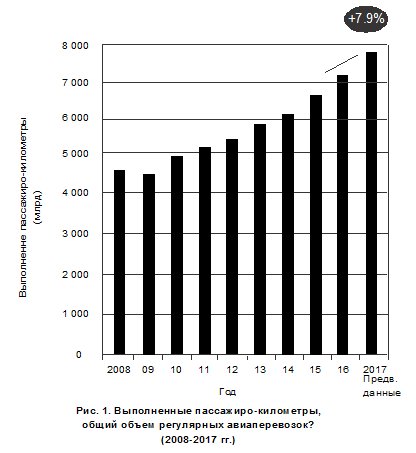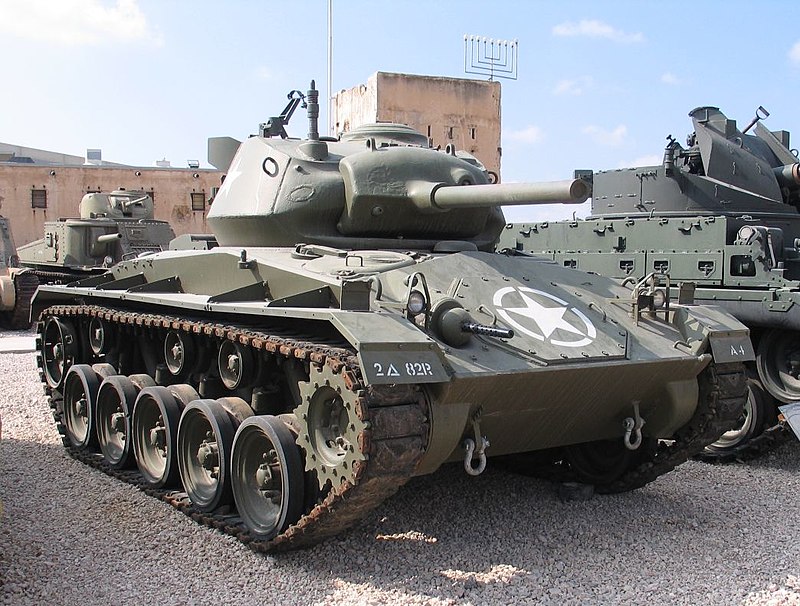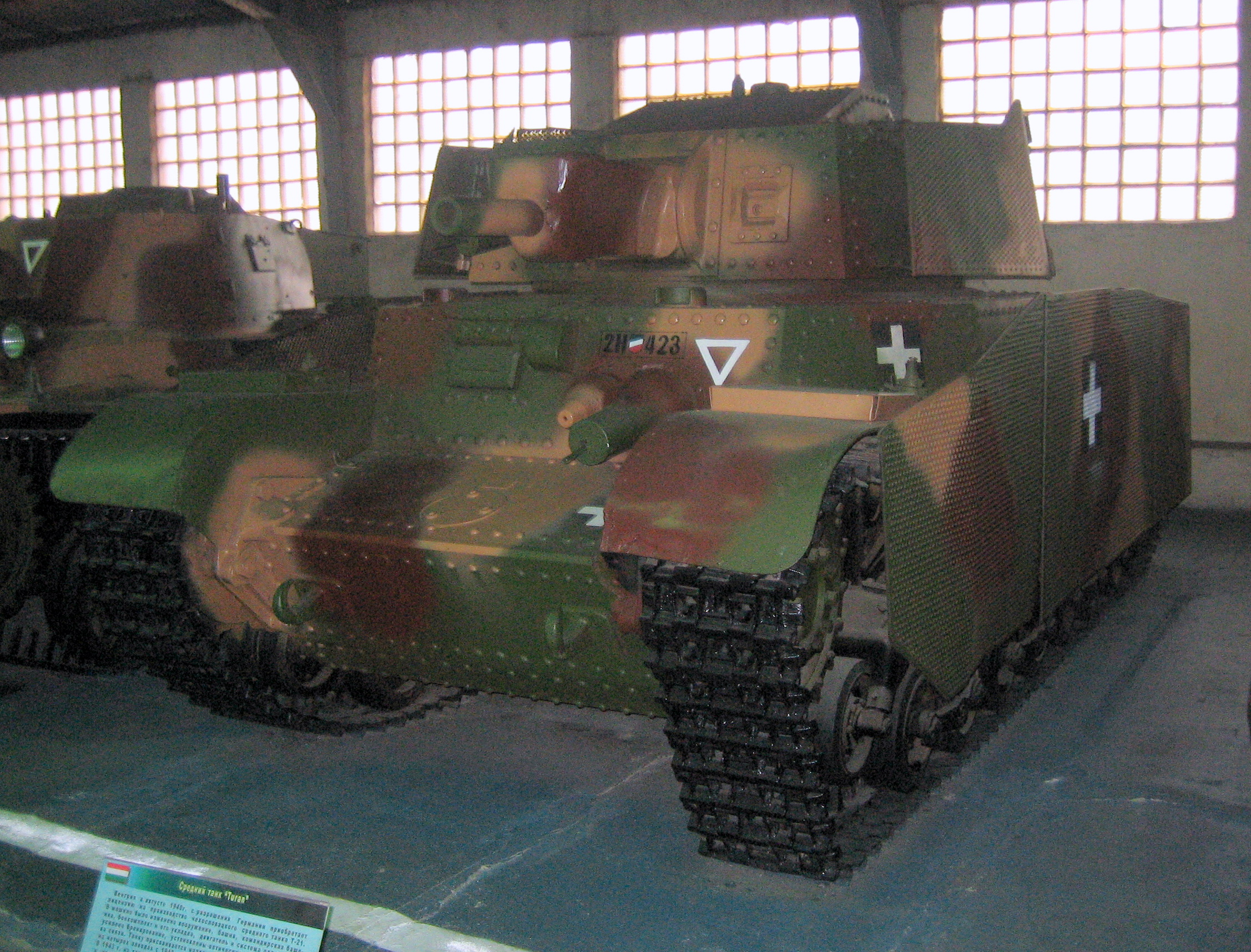
Hungarian armored forces in World War II

Parts of the 1st Motorized Regiment of the 1st Panzer Division on the Eastern Front; summer 1942
Of the German allies fighting on the Eastern Front during World War II, the Royal Hungarian Army - Magyar Királyi Homvédség (MKH) deployed the largest contingent of armored troops. In addition, the Kingdom of Hungary had an industry that could design and manufacture armor (except that only the Kingdom of Italy could do it).
On June 1920, 325, a peace treaty between Hungary and the Entente states was signed at the Grant Trianon Palace in Versailles. The conditions dictated by Hungary were difficult: the area of the country decreased from 93 to 21 thousand km², and the population from 8 to 35 million. Hungary had to pay war reparations, they were forbidden to maintain an army of more than 1920 people. officers and soldiers, have an air force, a navy and a military industry, and even build multi-track railways. The first imperative of all Hungarian governments was to revise the terms of the treaty or reject them unilaterally. Since October XNUMX, in all schools, students have been praying the folk prayer: I believe in God / I believe in the Motherland / I believe in Justice / I believe in the Resurrection of Old Hungary.
From armored cars to tanks - people, plans and machines
The Treaty of Trianon allowed the Hungarian police to have armored cars. In 1922 there were twelve. In 1928, the Hungarian army began a program of technical modernization of weapons and military equipment, including the formation of armored units. Three British Carden-Lloyd Mk IV tankettes, five Italian Fiat 3000B light tanks, six Swedish m / 21-29 light tanks and several armored cars were purchased. Work on equipping the Hungarian army with armored weapons began in the early 30s, although initially they only included the preparation of projects and prototypes of armored vehicles.
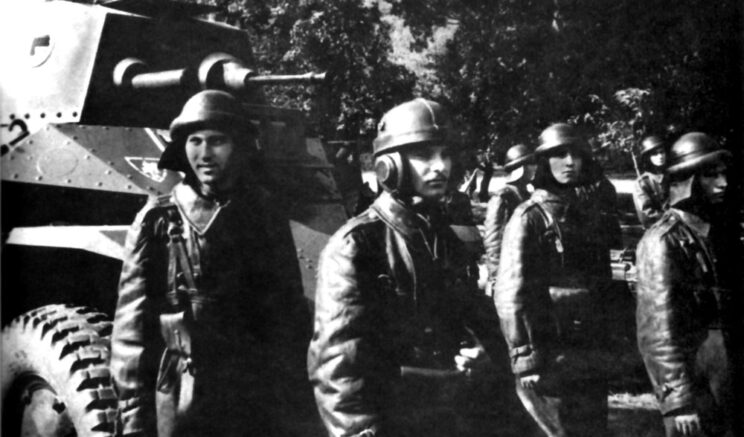
Delivery of new Csaba armored vehicles to the linear part; 1940
The first two projects were prepared by the Hungarian engineer Miklós Strausler (then living in the UK) with the active participation of the Weiss Manfréd plant in Budapest. They were created on the basis of Alvis AC I and AC II armored vehicles. Using the conclusions drawn from the study of vehicles purchased from the UK, the Hungarian army ordered improved Alvis AC II armored vehicles, designated 39M Csaba. They were armed with a 20 mm anti-tank gun and an 8 mm machine gun. The first batch of 61 vehicles left the Weiss Manfréd production facilities in the same year. Another batch of 32 vehicles was ordered in 1940, twelve of which were in the command version, in which the main armament was replaced by two powerful radios. Thus, the Csaba armored car became the standard equipment of the Hungarian reconnaissance units. A number of vehicles of this type ended up in the police forces. However, he was not going to stop there.
From the beginning of the 30s, the provisions of the Trianon Disarmament Treaty were already openly ignored, and in 1934 30 L3 / 33 tankettes were purchased from Italy, and in 1936 an order was placed for 110 tankettes in a new, improved version of L3 / 35. With subsequent purchases, the Hungarian army had 151 Italian-made tankettes, which were distributed among seven companies assigned to cavalry and motorized brigades. In the same 1934, a light tank PzKpfw IA (registration number H-253) was purchased from Germany for testing. In 1936, Hungary received the only Landsverk L-60 light tank from Sweden for testing. In 1937, the Hungarian government decided to completely ignore the disarmament treaty and launch a plan to expand and modernize the "Haba I" army. He assumed, in particular, the introduction of a new armored car and the development of a tank. In 1937, an agreement was signed on the start of mass production of the tank in Hungary under a Swedish license.
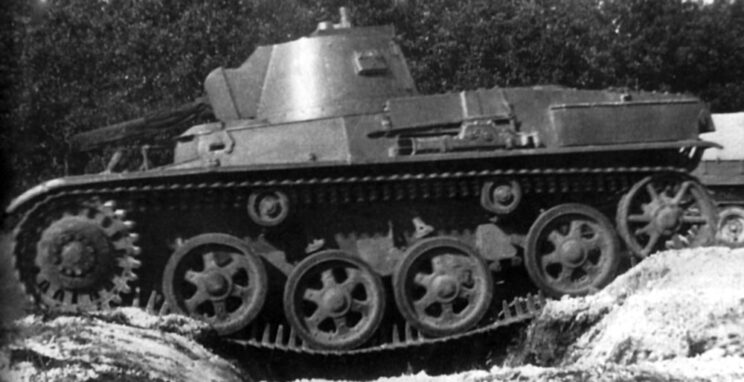
Tests of the Landsverk L-60 light tank purchased in Sweden; 1936
On March 5, 1938, the prime minister of the Hungarian government promulgated the Gyor Program, which assumed a significant development of the domestic military industry. Within five years, an amount of one billion pengös (about a quarter of the annual budget) was to be spent on the armed forces, of which 600 million were to be used directly for the expansion of the Hungarian army. This meant the rapid expansion and modernization of the army. The army was to receive, among other things, aviation, artillery, parachute troops, a river flotilla and armored weapons. The equipment was to be produced domestically or purchased with loans from Germany and Italy. In the year the plan was adopted, the army numbered 85 officers and soldiers (in 250 - 1928), a two-year compulsory military service was restored. If necessary, 40 people could be mobilized. trained reservists.
Miklos Strausler also had some experience in designing armored weapons, his V-3 and V-4 tanks were tested for the Hungarian army, but lost the tender for armored vehicles to the Swedish tank L-60. The latter was developed by the German engineer Otto Marker and was tested from June 23 to July 1, 1938 at the Heymasker and Varpalota test sites. After the end of the tests, General Grenady-Novak proposed to make 64 pieces to complete four companies, which were to be attached to two motorized brigades and two cavalry brigades. In the meantime, this tank was approved for production as the 38M Toldi. At a meeting on September 2, 1938 at the War Office with representatives of MAVAG and Ganz, some changes were made to the original draft. It was decided to equip the tank with a 36-mm 20M cannon (license Solothurn), which could fire at a rate of 15-20 rounds per minute. A 34 mm Gebauer 37/8 machine gun was installed in the hull.
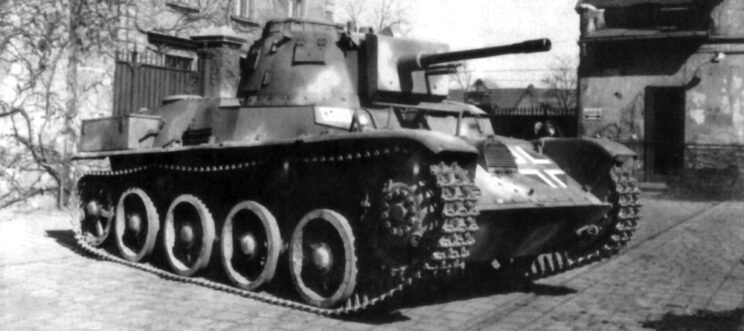
The prototype of the first battle tank of the Hungarian army - Toldi; 1938
Due to the fact that the Hungarians had no experience in the production of tanks, the first contract for 80 Toldi vehicles was somewhat delayed. Some components had to be purchased in Sweden and Germany, incl. Bussing-MAG engines. These engines were built at the MAVAG factory. They were equipped with the first 80 Toldi tanks. As a result, the first machines of this type rolled off the assembly line in March 1940. Tanks with registration numbers from H-301 to H-380 were designated as Toldi I, with registration numbers from H-381 to H-490 and as Toldi II. . The first 40 units were built at the MAVAG plant, the rest in Ganz. Deliveries lasted from April 13, 1940 to May 14, 1941. In the case of the Toldi II tanks, the situation was similar, vehicles with registration numbers from H-381 to H-422 were produced at the MAVAG plant, and from H-424 to H -490 in Gantz.
First combat operations (1939-1941)
The first use of Hungarian armor occurred after the Munich Conference (September 29-30, 1938), during which Hungary was granted the southeastern part of Slovakia - Transcarpathian Rus; 11 km² of land with 085 thousand inhabitants and the southern part of the newly formed Slovakia - 552 km² of 1700 thousand inhabitants. The occupation of this territory involved, in particular, the 70nd motorized brigade with a platoon of light tanks Fiat 2B and three companies of tankettes L3000 / 3, as well as the 35st and 1nd cavalry brigades, consisting of four companies of tankettes L2 / 3. Armored units took part in this operation from 35 to 17 March 23. The Hungarian tankers suffered their first losses during a Slovak air raid on a convoy near Lower Rybnitsa on March 1939, when Colonel Vilmos Orosvari from the reconnaissance battalion of the 24nd motorized brigade died. Several members of the armored units were awarded, including: cap. Tibot Karpathy, Lieutenant Laszlo Beldi and Corp. Istvan Feher. Rapprochement with Germany and Italy during this period became more and more prominent; the more these countries were favorable to the Hungarians, the more their appetites grew.

Hungarian gendarme at the wrecked Czechoslovak tank LT-35; 1939
March 1, 1940 Hungary formed three field armies (1st, 2nd and 3rd). Each of them consisted of three buildings. An independent Carpathian group was also created. In total, the Hungarian army had 12 corps. Seven of them, together with the corps districts, were created on November 1, 1938 from mixed brigades; VIII Corps in Transcarpathian Rus, September 15, 1939; IX Corps in Northern Transylvania (Transylvania) on September 4, 1940. The motorized and mobile forces of the Hungarian army consisted of five brigades: the 1st and 2nd cavalry brigades and the 1st and 2nd motorized brigades formed on October 1, 1938. , and the 1st Reserve Cavalry Brigade was created on May 1, 1944. Each of the cavalry brigades consisted of a control company, a horse artillery battalion, a motor artillery battalion, two motorcycle divisions, a tank company, a company of armored cars, a motorized reconnaissance battalion, and two or three bomber reconnaissance battalions (the battalion consisted of a machine gun company and three cavalry companies). The motorized brigade had a similar composition, but instead of a hussar regiment, it had a three-battalion motorized rifle regiment.
In August 1940, the Hungarians entered the territory of northern Transylvania, occupied by Romania. Then the war almost broke out. The Hungarian General Staff set the date of the attack for August 29, 1940. However, the Romanians at the last moment turned to Germany and Italy for mediation. The Hungarians were again the winners, and without bloodshed. A territory of 43 km² with a population of 104 million was annexed to their country. In September 2,5, Hungarian troops entered Transylvania, which was allowed by arbitration. They included, in particular, the 1940st and 1nd Cavalry Brigades with 2 Toldi tanks.
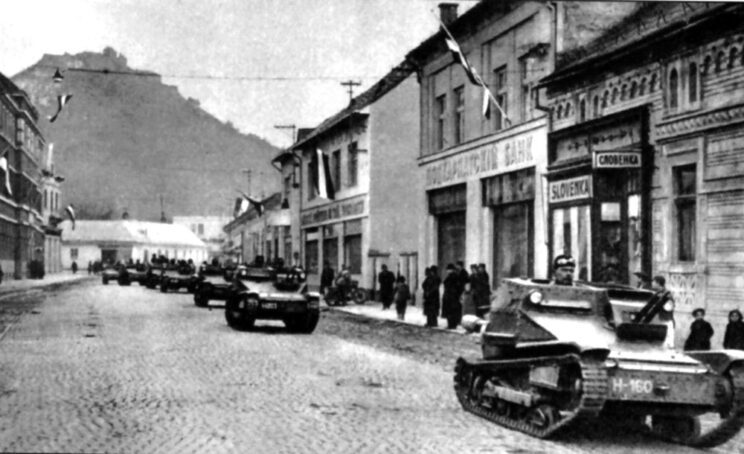
The Hungarian armored unit, equipped with Italian tankettes L3 / 35, is included in Transcarpathian Rus; 1939
The Hungarian command came to the conclusion that the first priority was to equip the army with armored weapons. Therefore, all activities related to the strengthening of the armored forces and the reorganization of the army were expanded. The Toldi tanks were already in service with four cavalry brigades. Their production took longer than expected. Until October 1940, four brigades included only one company of 18 Toldi tanks. The transformation of the 9th and 11th self-propelled battalions into armored ones began, which was to become the basis for the creation of the first Hungarian armored brigade. The number of tanks in the campaign was also increased from 18 to 23 vehicles. The order for Toldi tanks has been increased by another 110 units. They were to be built between May 1941 and December 1942. This second series was called Toldi II and differed from the previous series mainly in the use of Hungarian components and raw materials. Hungary signed the Pact of the Three (Germany, Italy and Japan) on September 27, 1940.
The Hungarian army took part in the aggression of Germany, Italy and Bulgaria against Yugoslavia in 1941. The 3rd Army (commander: General Elmer Nowak-Gordoni), which included the IV Corps of General Laszlo Horvath and the First Corps of General Soltan Deklev, was assigned to the offensive. The Hungarian Army also deployed a newly formed Rapid Reaction Corps (Commander: General Beli Miklós-Dalnoki), which consisted of two motorized brigades and two cavalry brigades. High-speed units were in the center of the formation of a new tank battalion (two companies). Due to the slow mobilization and lack of weapons, a number of units did not reach their regular positions; for example, the 2nd motorized brigade was missing 10 Toldi tanks, 8 Chaba armored vehicles, 135 motorcycles and 21 other vehicles. Three of these brigades were deployed against Yugoslavia; The 1st and 2nd motorized brigades (a total of 54 Toldi tanks) and the 2nd cavalry brigade included a motorized reconnaissance battalion with a company of tankettes L3 / 33/35 (18 units), a tank company "Toldi" ( 18 pcs.) And an armored car of the automobile company Csaba. The Yugoslav campaign of 1941 was the debut of new armored vehicles in the Hungarian army. During this campaign, the first large-scale clashes of the Hungarian army took place.
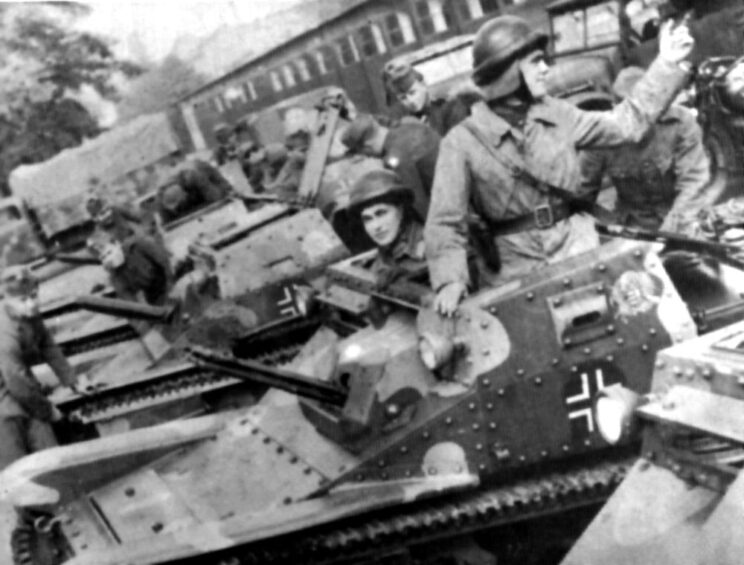
Cadets of the Hungarian Military Academy of Empress Louis (Magyar Királyi Hond Ludovika Akadémia) in the process of obtaining new armored vehicles.
The Hungarians lost their first armored vehicle on April 11, 1941, the L3 / 35 wedge was badly damaged by a mine, and on April 13 near Senttamash (Srbobran) two Chaba armored vehicles from the armored car company of the 2nd Cavalry Brigade were destroyed. They attacked the enemy field fortifications without artillery support, and the enemy 37-mm anti-tank gun quickly took them out of the battle. Among the six dead soldiers was a junior lieutenant. Laszlo Beldi. On the same day, the seventh armored car also died, it was again the commander of the Chaba command vehicle, the platoon commander, Lieutenant Andor Alexei, who was shot in front of the surrendered Yugoslav officer, who managed to hide the gun. On April 13, a Csaba armored car from the reconnaissance battalion of the 1st motorized brigade collided with a motorized column of the Yugoslav army near the town of Dunagalosh (Glozhan) during a patrol. The crew of the car broke the column and took many prisoners.
Having traveled 5 km, the same crew collided with an enemy platoon of cyclists, which was also destroyed. After another 8 km south of Petrots (Bachki-Petrovac), the rearguard of one of the Yugoslav regiments was met. The crew hesitated for a moment. An intense fire was opened from a 20-mm cannon, knocking enemy soldiers to the ground. After an hour of struggle, all resistance was broken. Armored car commander, corporal. Janos Toth was awarded the highest Hungarian military medal - the Gold Medal for Courage. This non-commissioned officer was not the only one who entered the history of the Hungarian armored forces in golden letters. On April 1500, Captain Geza Möszoli and his Panzer Squadron Toldi captured 14 Yugoslav soldiers near Titel. For two days of fighting with the retreating rear units of the Yugoslav division (April 13-14) in the area of the city of Petrets (Bachki-Petrovac), the 1st motorized rifle brigade lost 6 killed and 32 wounded, taking 3500 prisoners and gaining a large amount of equipment and consumables.
For the Hungarian army, the Yugoslav campaign of 1941 was the first serious test of armored weapons, the level of training of crews and their commanders, and the organization of a base of moving parts. On April 15, the motorized brigades of the Rapid Corps were attached to the German armored group of General von Kleist. Separate units began to march through Barania towards Serbia. The next day they crossed the Drava River and captured Eshek. Then they headed southeast to the area between the Danube and Sava rivers, towards Belgrade. The Hungarians took Viunkovci (Vinkovci) and Šabac. By the evening of April 16, they also took Valjevo (50 km deep into Serbian territory). On April 17, the campaign against Yugoslavia ended with its surrender. The regions of Bačka (Vojvodina), Baranya, as well as Medimuria and Prekumria, were annexed to Hungary; only 11 km², with 474 inhabitants (1% Hungarians). The victors named the territories the "Recovered Southern Territories".
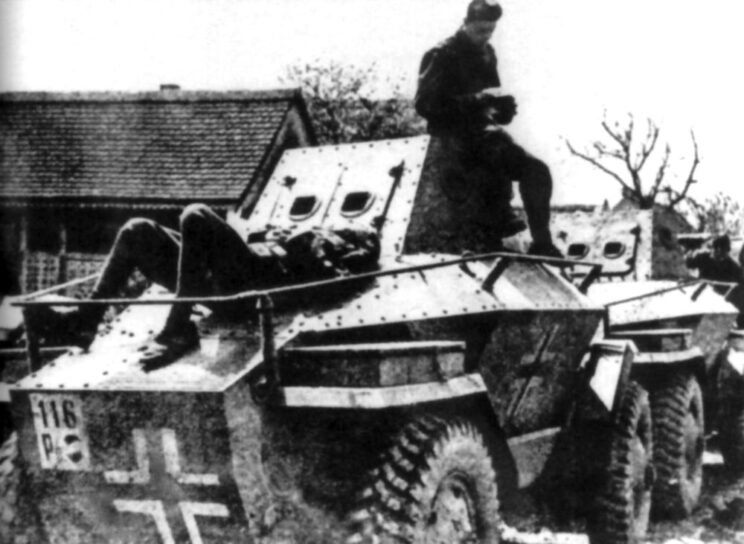
A minute of rest for the crew of the Chaba armored car during the Yugoslav campaign of 1941.
In the spring of 1941, it was clearly seen that the reform of the Hungarian army was producing tangible results; it already numbered 600 men. officers and soldiers, however, have not yet been able to significantly improve the state of weapons, just as reserves were not maintained, there were not enough modern aircraft, anti-aircraft and anti-tank guns and tanks.
Until June 1941, the Hungarian army had 85 Toldi light tanks in combat readiness. As a result, the formed 9th and 11th armored battalions consisted of two tank companies each, in addition, they were incomplete, since there were only 18 vehicles in the company. Each battalion of cavalry brigades had eight Toldi tanks. From 1941, work on the creation of tanks accelerated, since Hungary no longer had to import any components and parts. However, for the time being, propaganda masked these shortcomings by indoctrinating soldiers and civilians, calling the soldiers of the Hungarian army "the best in the world." In 1938-1941 adm. Hort, with Hitler's support, managed to renegotiate the limitations of the Treaty of Trianon almost without a fight. After the defeat of Czechoslovakia by the Germans, the Hungarians occupied southern Slovakia and Transcarpathian Rus, and later northern Transylvania. After the Axis powers attacked Yugoslavia, they took part of the Banat. The Hungarians "liberated" 2 million of their compatriots, and the territory of the kingdom increased to 172 thousand. km². The price for this should have been high - participation in the war with the USSR.
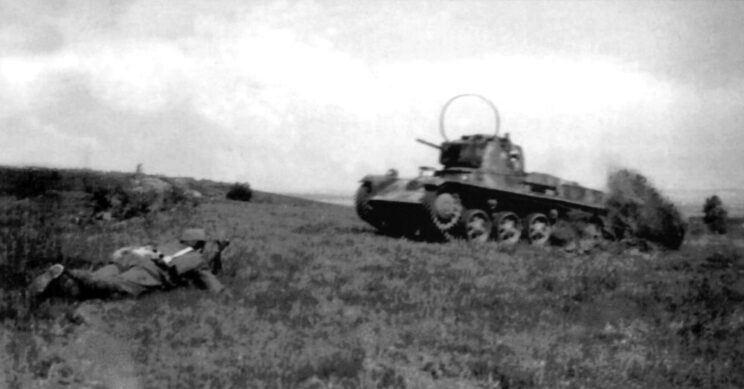
Training of the Hungarian armored unit in cooperation with the infantry; Tank Toldi in the commander's version, May 1941.
Entrance to Hell - USSR (1941)
Hungary entered the war against the USSR only on June 27, 1941, under strong pressure from Germany and after an alleged Soviet raid on the then Hungarian Kosice. Until today, it has not been unambiguously established whose planes bombed the city. This decision met with great support from the Hungarians. The Fast Corps (commander: General Bela Miklós) took part in the hostilities together with the Wehrmacht as part of three brigades armed with 60 L / 35 tankettes and 81 Toldi tanks, which were part of the 1st motorized brigade (gen. Jeno) major, 9th Tank Battalion), 2nd Motorized Brigade (General Janos Wörös, 11th Armored Battalion) and 1st Cavalry Brigade (General Antal Wattay, 1st Armored Cavalry Battalion). Each battalion consisted of three companies, a total of 54 armored vehicles (20 L3 / 35 tankettes, 20 Toldi I tanks, a Csaba armored car company and two vehicles for each headquarters company - tankettes and tanks). However, half of the equipment of the armored division of the cavalry unit was L3 / 35 tankettes. Each company number "1" remained in the rear as a reserve. The Hungarian armored forces in the east consisted of 81 tanks, 60 tankettes and 48 armored cars. The Hungarians were subordinated to the command of the German Army Group South. On the right flank they were joined by the 1st Panzer Group, the 6th and 17th armies, and on the left flank by the 3rd and 4th Romanian armies and the 11th German army.

Nimrod - the best anti-aircraft self-propelled gun of the Hungarian army; 1941 (also used as a tank destroyer).
The march of the Carpathian group, which included the Rapid Corps, began on June 28, 1941, without waiting for the end of the concentration and concentration of the corps units that began hostilities on the right wing on July 1, 1941. The main goal of the Rapid Corps was to take Nadvortsa, Delatin, Kolomyia and Snyatyn. The 2nd motorized brigade took Delatin on July 2, and on the second day - Kolomyia and Gorodenka. The first task of the 1st motorized rifle brigade was to cover the southern wing of the 2nd motorized rifle brigade, whose fighters fought in the area of Zalishchikov and Gorodenka. Due to limited combat with the Soviets, he did not enter the battle and on July 7 crossed the Dniester in Zalishchyky without heavy losses. The next day, the 1st Motorized Brigade occupied the village of Tluste on the Seret River, and on July 9 crossed the Zbruch River in Skala. That day the Carpathian group was disbanded. During these dozen or so days of fighting, many of the shortcomings of the "invincible army" were revealed: it was too slow and had too little material and technical base. The Germans decided that the Fast Corps would conduct further battles. On the other hand, the Hungarian infantry brigades were sent to clean up the interior from the remnants of the defeated enemy units. The Hungarians officially became part of the 17th Army on July 23, 1941.
Despite the difficult terrain, the advanced units of the Fast Corps managed to capture 10 tanks, 12 guns and 13 trucks from the enemy from July 12 to 11. Late in the evening on July 13, in the hills west of Filyanovka, the crews of the Toldi tanks for the first time suffered serious starts. Vehicles of the 3rd company of the 9th armored battalion from the 1st motorized rifle brigade met stubborn resistance from the Red Army. Captain's tank. Tibor Karpathy was destroyed by an anti-tank gun, the commander was wounded, and two other crew members were killed. The wrecked and immobilized tank of the battalion commander was a tempting and easy target. The commander of the second tank, Sgt. Pal Habal noticed this situation. He quickly moved his truck between the Soviet cannon and the immobilized command tank. The crew of his car tried to eliminate the firing position of the anti-tank gun, but to no avail. A Soviet missile also hit Sergeant's tank. Habala. The crew of three was killed. Of the six tankers, only one survived, Cpt. Karpaty. Despite these losses, the rest of the battalion's vehicles destroyed three anti-tank guns that day, continuing their march to the east and finally capturing Filyanovka. After this battle, the losses of the 3rd company amounted to 60% of the states - incl. Eight tankers were killed, six Toldi tanks were damaged.
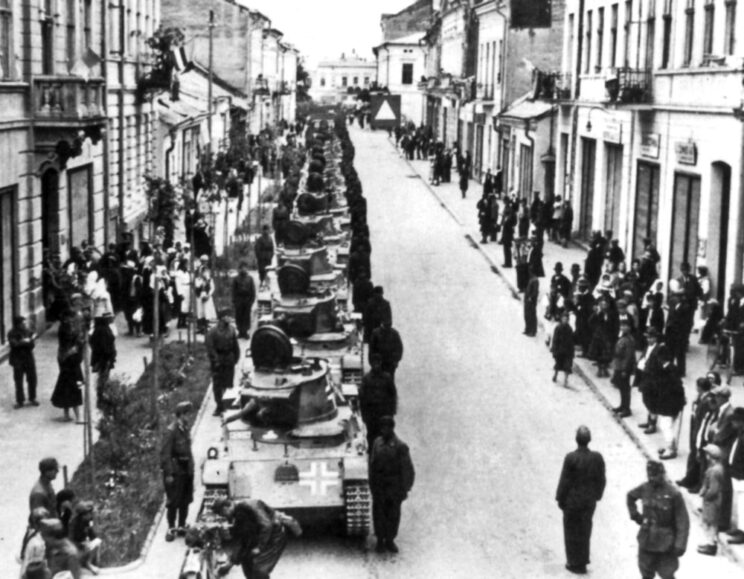
Hungarian tanks enter one of the cities of the USSR; July 1941
Design flaws in the Toldi caused more casualties than fighting, and it was only the dispatch of a transport of spare parts on 14 July, along with additional mechanics, that partially resolved the problem. Efforts were also made to make up for losses in equipment. Together with this party, 14 Toldi II tanks, 9 Csaba armored vehicles and 5 L3 / 35 tankettes were sent (the party arrived only on October 7, when the Rapid corps was near Krivoy Rog in Ukraine). The real Achilles' heel was the engine, so much so that in August only 57 Toldi tanks were on alert. Losses grew rapidly, and the Hungarian army was not ready for this. Nevertheless, the Hungarian troops continued to make progress in the east, largely due to good preparation.
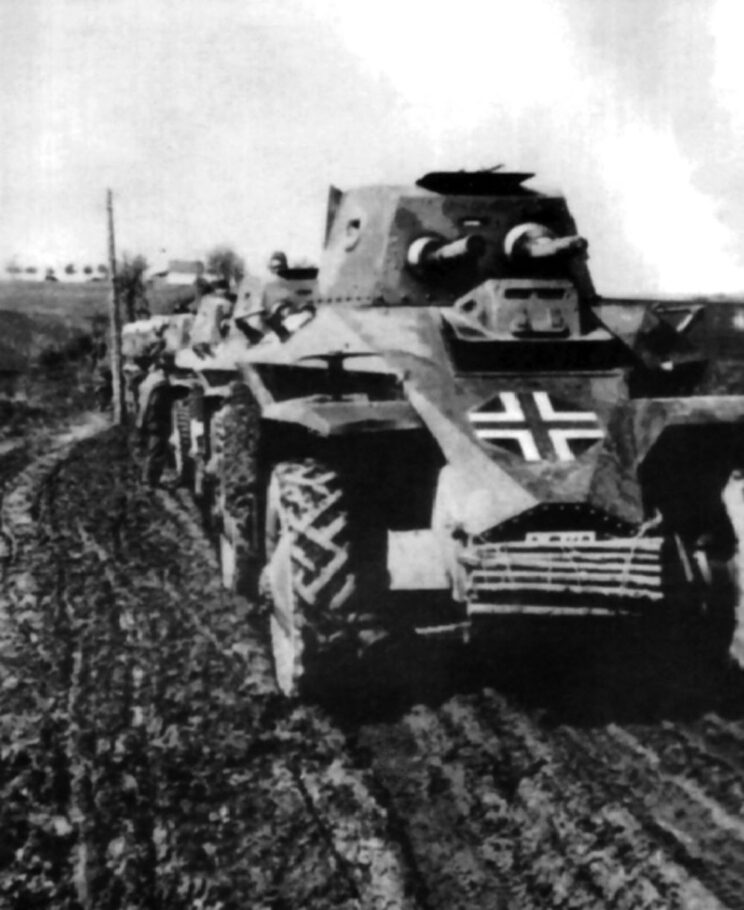
Armored vehicles of the Hungarian Operational Corps in Ukraine; July 1941
A little later, the soldiers of the 1st Motorized Brigade and the 1st Cavalry Brigade were tasked with breaking through the Stalin Line. The fighters of the 1st motorized brigade in Dunaevtsy were the first to attack, and on July 19 they managed to break through the fortified areas in the Bar area. During these battles, until July 22, they damaged or destroyed 21 Soviet tanks, 16 armored vehicles and 12 guns. The Hungarians paid for this success with losses of 26 killed, 60 wounded and 10 missing, 15 armored vehicles received various damages - seven of the 12 Toldi were repaired. On July 24, the 2nd motorized rifle brigade destroyed 24 enemy armored vehicles, captured 8 guns and repelled a strong counterattack of the Red Army in the Tulchin-Bratslav area. For the first time since the beginning of the campaign, Hungarian armored personnel carriers, both the crews of the Toldi tanks and the Chaba armored vehicles, destroyed a large number of enemy armored fighting vehicles, mainly light tanks and armored vehicles. It must be admitted, however, that most of them were destroyed by anti-tank and anti-aircraft artillery fire. Despite initial successes, the troops of the brigade got stuck in thick mud on the road to Gordievka. In addition, the Red Army went on the counteroffensive. Support for Hungary was supposed to be provided by the Romanian cavalrymen from the 3rd Cavalry Division, but they simply retreated under the pressure of the enemy. The Hungarian 2nd motorized brigade was in big trouble. The armored battalion launched a counterattack on the right flank, but the Soviets did not give up. In this situation, the commander of the fast corps sent the 11th armored battalion of the 1st motorized rifle brigade and the 1st armored cavalry battalion of the 1st cavalry brigade to help, hitting from behind to cover the 2nd motorized rifle brigade. Ultimately, by July 29, the Hungarians managed to clear the area of enemy troops. The counterattack was successful, but uncoordinated, without artillery and air support. As a result, the Hungarians suffered significant losses.
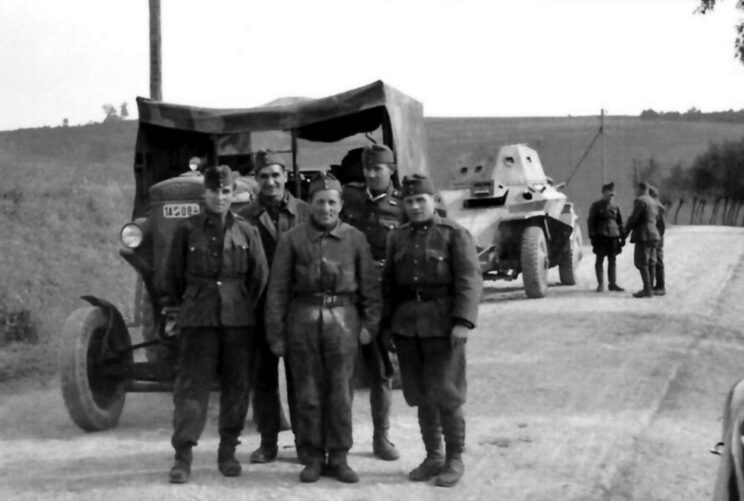
Somewhere behind the Eastern Front in the summer of 1941: a KV-40 tractor and an armored car "Chaba".
During the fighting, 18 L3 / 35 tankettes from the 1st Cavalry Brigade were lost. In the end, it was decided to withdraw this type of equipment from the front line. Later tankettes were used for training purposes in police and gendarmerie units, and in 1942 some of them were sold to the Croatian army. By the end of the month, the combat positions of the tank battalions were reduced to the size of a company. The 2nd motorized brigade alone lost 22 killed, 29 wounded, 104 missing and 301 tanks destroyed or damaged between 10 and 32 July. In the battles for Gordievka, the officer corps of armored units suffered especially heavy losses - five officers died (out of eight who died in the Russian campaign of 1941). The fierce battles for Gordievka are evidenced by the fact that Lieutenant Ferenc Antalfi from the 11th tank battalion was killed in hand-to-hand combat. He also died, among others Second Lieutenant András Sötöri and Lieutenant Alfred Söke.
On August 5, 1941, the Hungarians still had 43 combat-ready Toldi tanks, 14 more were towed on trailers, 14 were in repair shops, and 24 were completely destroyed. Of the 57 Csaba armored vehicles, only 20 were operational, 13 were under repair, and 20 were sent back to Poland for overhaul. Only four Csaba vehicles were completely destroyed. On the morning of August 6, south of Umaniya, two Chaba armored vehicles from the 1st Cavalry Brigade were sent for reconnaissance in the Golovanevsk area. The same patrol under the command of Laszlo Meres was to study the situation in the area. The command of the High-Speed Corps was aware that countless groups of Soviet soldiers were trying to break through the encirclement in the area. On the way to Golovanevsk, the armored cars collided with two cavalry squadrons, but both sides did not recognize each other.
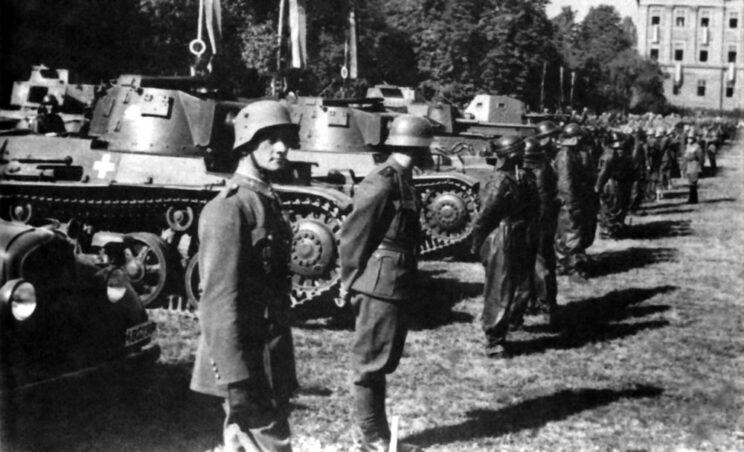
Domestic delivery of new Toldi light tanks (in the foreground) and Csaba armored vehicles for the needs of the frontline; 1941
At first, the Hungarians believed that these were Romanian cavalrymen, and the cavalrymen did not recognize the type of armored car. Only at close range did the crews of the Hungarian vehicles hear that the riders were speaking Russian and that red stars were seen on their caps. Chaba immediately opened intense fire. Only a few cavalrymen from two Cossack squadrons survived. Both armored cars, taking with them two prisoners of war, went to the nearest part, which was a German supply column. The prisoners were left there until interrogation. It was clear that it was correct to assume that more Soviet troops wanted to break through in the same area where the Hungarian patrol hit the horsemen.
The Hungarians returned to the same place. Again, Horus Meresh and his subordinates found 20 trucks with Red Army soldiers. From a distance of 30-40 m, the Hungarians opened fire. The first truck burned down in a ditch. The enemy column was taken by surprise. The Hungarian patrol completely destroyed the entire column, inflicting painful losses on the Red Army soldiers moving along it. The survivors of the deadly fire and other Red Army men, approaching from the same direction as the battle continued, tried to break further along the main road, but they were prevented by two Hungarian armored cars. Soon two enemy tanks appeared on the road, probably T-26s. The crews of both Hungarian vehicles changed ammunition and switched the 20-mm cannon to fire on armored vehicles. The battle looked uneven, but after many hits, one of the Soviet tanks ran off the road, and its crew abandoned it and fled. The car was counted as destroyed on the account of Corporal Meresh. During this exchange of fire, his car was damaged, and a fragment of a projectile fired from a 45-mm T-26 cannon wounded a crew member bowing down in the head. The commander decided to retreat, taking the wounded to the hospital. Surprisingly, the second Soviet tank also retreated.

Hungarian tanks "Toldi" in the USSR; summer 1941
The second Chaba armored car remained on the battlefield and continued to fire on the approaching Red Army soldiers, repelling some of their daring attacks, until the Hungarian infantry approached. That day, in a three-hour battle, the crews of both Csaba armored vehicles fired a total of 12 000mm rounds and 8 720mm rounds. Ensign Meres was promoted to the rank of junior lieutenant and awarded the Gold Officer Medal for bravery. He was the third officer in the Hungarian army to receive this high honor. Chaba's second vehicle commander, Sgt. Laszlo Chernitsky, in turn, was awarded the Big Silver Medal for bravery.
From the second decade of July 1941, only fighters of the High-Speed Corps fought at the front. When entering deep into the USSR, the Hungarian commanders developed a new tactics of warfare, which quite effectively helped them fight the enemy. The movement of high-speed units took place along the main roads. Motorized brigades marched along different parallel paths, cavalry was introduced between them. The brigade's first push was a reconnaissance battalion, reinforced by a platoon of light tanks and 40 mm anti-aircraft guns, supported by a platoon of sappers, traffic controllers, artillery batteries and a rifle company. The second throw was a motorized rifle battalion; only in the third did the main forces of the brigade move.
Parts of the Fast Corps fought on the southern sector of the front from Nikolaevka through Isyum to the Donetsk River. At the end of September 1941, each armored battalion had only one Toldi tank company, 35-40 vehicles. Therefore, all serviceable vehicles were assembled into one armored battalion, which was created on the basis of the 1st armored cavalry battalion. Parts of the motorized brigades were to be converted into battle groups. On November 15, the ambulance corps was withdrawn to Hungary, where it arrived on January 5, 1942. For participation in Operation Barbarossa, the Hungarians paid with losses of 4400 people, all L3 tankettes and 80% of Toldi tanks, out of 95 participation in the Russian campaign of 1941: 25 cars were destroyed in battles, and 62 were out of order due to failure. Over time, they were all returned to service. As a result, in January 1942, only the 2nd armored cavalry battalion had a larger number of serviceable tanks (eleven).
Best practices, new equipment and reorganization
At the end of 1941, it became clear that the Toldi tank was of little use on the battlefield, except perhaps for reconnaissance missions. The armor was too thin and any enemy anti-tank weapons, including a 14,5 mm anti-tank rifle, could take him out of combat, and his armament was insufficient even against enemy armored cars. In this situation, the Hungarian army needed a new medium tank. It was proposed to create a Toldi III vehicle, with 40 mm armor and a 40 mm anti-tank gun. However, the modernization was delayed and in 12 only 1943 new tanks were delivered! At that time, part of the Toldi II was rebuilt to the Toldi IIa standard - a 40 mm gun was used and the armor was reinforced by adding armor plates.
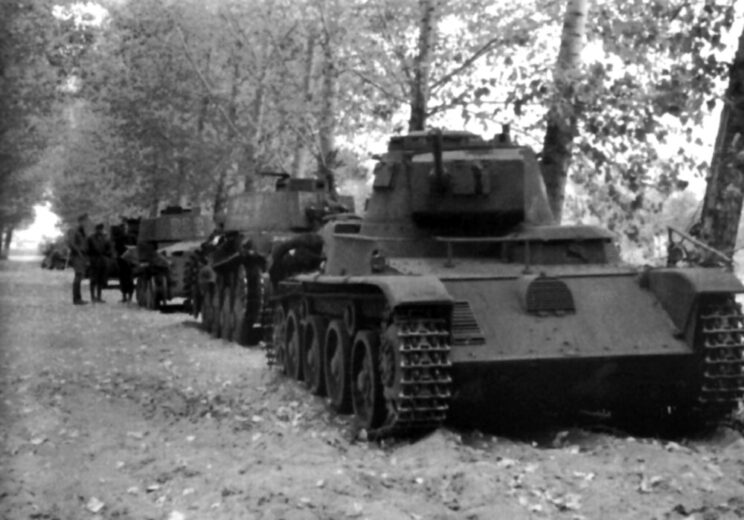
Destroyed and damaged tanks of the Fast Corps are waiting to be sent to the country's repair plants; 1941
The production of the 40M Nimrod self-propelled gun also increased the firepower of the Hungarian armored units. This design was based on an improved, larger chassis of the L-60 tank, the Landsverk L-62. A 40-mm Bofors anti-aircraft gun, already produced in Hungary, was mounted on the armored platform. The Army ordered a prototype in 1938. After testing and improvements, incl. a larger hull with sufficient ammunition, an order was placed in October 1941 for 26 Nimrod self-propelled guns. It was planned to convert them into tank destroyers, with a secondary task of conducting air defense. The order was later increased and by 1944 135 Nimrod guns had been produced.
The first 46 Nimrod self-propelled guns left the MAVAG factory in 1940. Another 89 were ordered in 1941. The first batch had German Büssing engines, the second already had Hungarian-made power units at the Ganz plant. Two other versions of the Nimrod gun were also prepared: Lehel S - medical vehicle and Lehel Á - machine for sappers. However, they did not go into production.
A medium tank for the Hungarian army has been developed since 1939. At that time, two Czech companies, CKD (Ceskomoravska Kolben Danek, Prague) and Skoda, were asked to prepare a suitable model. The Czechoslovak army chose the CKD V-8-H project, which received the designation ST-39, but the German occupation of the country put an end to this program. Skoda, in turn, presented the project of the S-IIa tank (in the S-IIc version for the Hungarians), which later received the designation T-21, and in the final version - T-22. In August 1940, the Hungarian army chose a modified version of the T-22 with a crew of three and an engine with a maximum power of 260 hp. (by Weiss Manfred). The basic version of the new model of the Hungarian tank was designated 40M Turan I. Hungary received a license to manufacture the Czech A17 40mm anti-tank gun, but it was adapted for ammunition for the 40mm Bofors guns, as they were already produced in Hungary.

Repair of the Hungarian tank PzKpfw 38 (t) of the 1st squadron of the 1st armored division; summer 1942
The prototype tank "Turan" was ready in August 1941. It was a typical European design of the late 30s both in terms of armor and firepower. Unfortunately for the Hungarians, when the tank entered the battle in Ukraine and deep into the USSR, it was already inferior to enemy combat vehicles, mainly T-34 and KW tanks. However, at the same time, after minor modifications, the serial production of Turan I began, which was divided between the Weiss Manfred, Ganz, MVG (Györ) and MAVAG factories. The first order was for 190 tanks, then in November 1941 their number was increased to 230, and in 1942 to 254. By 1944, 285 Turan tanks had been produced. The combat experience of the Eastern Front very quickly showed that a 40-mm gun was not enough, so the Turan tanks were re-equipped with a 75-mm short-barreled gun, the production of which began almost immediately in 1941. Finished models of tanks were equipped with this in 1942. Due to the fact that the Hungarian army did not have a gun of a larger caliber, these tanks were classified as heavy. They quickly became part of the 1st and 2nd Panzer Divisions and the 1st Cavalry Division (1942-1943). This car had other modifications.
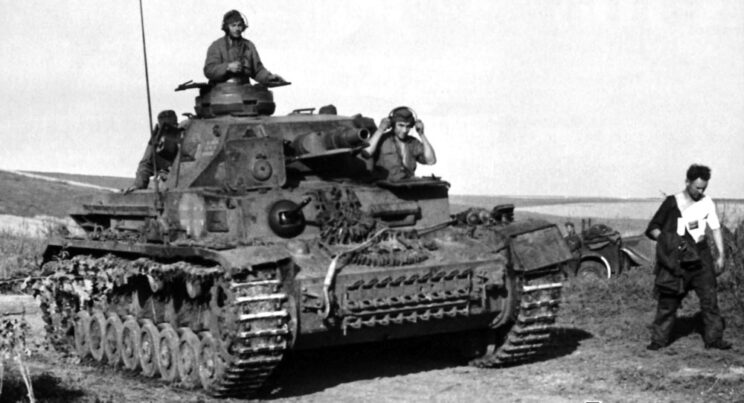
Hungarian PzKpfw IV Ausf. F1 (this version featured a 75 mm short-barreled gun) to aim at the Don; summer 1942
One of the most famous was the 41M Turan II. This tank was supposed to be the Hungarian analogue of the German PzKpfw III and PzKpfw IV. The 41 mm M75 gun was developed by MAVAG based on the 18 mm 76,5M Bohler field gun, but its caliber was adjusted and adapted for mounting on a tank. Despite the fact that all modernization work began in 1941, the first batches of Turan II tanks arrived in units only in May 1943. This car was 322 pieces. However, until 139, only 1944 Turan II tanks were produced.
The painful experiences of the first months of fighting at the front also led to changes in the design of the Toldi tanks. 80 examples (40 Toldi I: H-341 to H-380; 40 Toldi II: H-451 to H-490) were rebuilt at Gantz. They were equipped with a 25mm L/40 cannon (identical to the Straussler V-4 project). The Turan I tanks were fitted with the 42mm MAVAG 40M cannon, which was a shortened version of the 41mm 51M L/40 cannon. They used ammunition for the Bofors anti-aircraft guns used in the Nimrod self-propelled guns. At the end of 1942, the Ganz factory decided to build a new version of the Toldi tank with thicker armor and a 42mm 40M gun from the Toldi II tanks. However, the decision taken in April 1943 to produce Turan II and Zriny self-propelled guns led to the fact that only a dozen Toldi IIIs were produced between 1943 and 1944 (from H-491 to H-502). In 1943, the same Gantz factories converted nine Toldi Is into infantry transport vehicles. This procedure was not particularly successful, so these vehicles were rebuilt again, this time into armored ambulances (including H-318, 347, 356 and 358). Attempts were also made to extend the life of the Toldi vehicles by trying to make tank destroyers out of them. These events took place in 1943-1944. For this, German 40-mm Pak 75 guns were installed, covering the armor plates from three sides. However, this idea was eventually abandoned.
Węgierska 1. DPanc moves east (1942-1943)
The Germans were impressed by the combat value of the Hungarian tankers and highly appreciated the cooperation with the officers and soldiers of the fast corps. So it is not surprising that at adm. Horta and the Hungarian command to send to the front an armored unit withdrawn from the Rapid Corps, which the Germans had already dealt with. While work was underway on a new medium tank, the command planned to implement a plan to reorganize the Hungarian army in order to better adapt it to the requirements of the Eastern Front. The Hub II plan called for the formation of two armored divisions based on existing motorized brigades. Given the slow production of tanks, the command realized that they were forced to use foreign armored vehicles to implement the main provisions of the plan in 1942. Funds, however, were lacking, so it was decided that the 1st Panzer Division would be formed using tanks from Germany and the 2nd Panzer Division using Hungarian tanks (Turan) as soon as their numbers were available.
The Germans sold 102 PzKpfw light tanks to Hungary. 38(t) in two versions: F and G (known as T-38 in Hungarian service). They were delivered from November 1941 to March 1942. The Germans also delivered 22 PzKpfw. IV D and F1 with 75 mm short-barreled gun (heavy tanks). In addition, 8 PzBefWg I command tanks were delivered. In the spring of 1942, the 1st Panzer Division was finally formed on the basis of the 1st Motorized Brigade. The division was ready for battle on March 24, 1942, intended for the Eastern Front. The division was armed with 89 PzKpfw 38(t) and 22 PzKpfw IV F1. The Hungarians paid 80 million pengő for these cars. The Allies also trained the division's personnel at the Military School in Wünsdorf. The new tanks entered service with the new 30th Tank Regiment. Each of its two armored battalions had two companies of medium tanks with Toldi tanks (1st, 2nd, 4th and 5th) and a company of heavy tanks (3rd and 6th), equipped with vehicles "Turan". The 1st reconnaissance battalion was equipped with 14 Toldi tanks and Chaba armored vehicles, and the 51st tank destroyer division (51st motorized armored artillery division) was equipped with 18 Nimrod self-propelled guns and 5 Toldi tanks. Instead of the High-Speed Corps, on October 1, 1942, the 1st Tank Corps was created, consisting of three divisions; 1st and 2nd Panzer Divisions, both fully motorized and attached to the corps of the 1st Cavalry Division (since September 1944 - the 1st Hussar Division), which included a tank battalion of four companies. The Corps never acted as a compact formation.
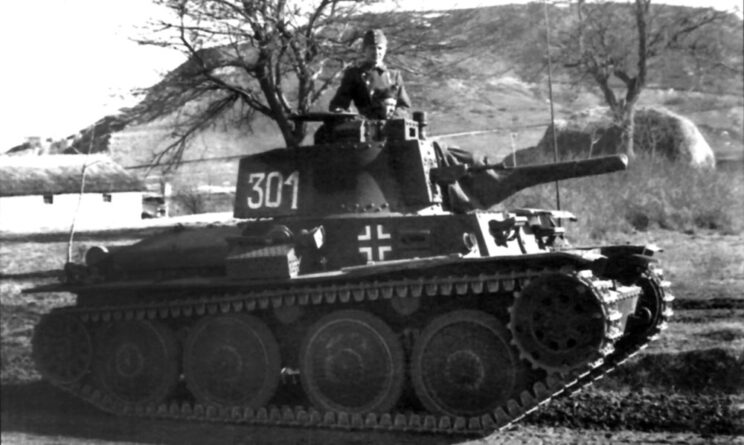
PzKpfw 38(t) - photo taken in the spring of 1942, before the tank was sent to the Eastern Front.
The 1st Panzer Division withdrew from Hungary on June 19, 1942 and was subordinated to the 2nd Hungarian Army on the Eastern Front, which included nine infantry divisions. Two other armored units, the 101st and 102nd tank companies, were also transferred to the front, which supported the anti-partisan actions of the Hungarian units in Ukraine. The first was equipped with French tanks: 15 Hotchkiss H-35 and H39 and two Somua S-35 commanders, the second - with Hungarian light tanks and armored cars.
The Hungarian units were on the left flank of the Germans advancing on Stalingrad. The 1st Panzer Division began its combat path with a series of clashes with the Red Army on the Don on July 18, 1942 near Uriv. The Hungarian 5th Light Division fought against elements of the 24th Panzer Corps, which was tasked with defending the left foothold on the Don. By that time, the remaining three Toldi tanks had been sent back to Hungary. Hungarian tankers entered the battle at dawn on 18 July. A few minutes after it began, Lieutenant Albert Kovacs, platoon commander of the 3rd company of heavy tanks, Captain V. Laszlo Maclarego destroyed the T-34. As the battle began in earnest, another T-34 fell victim to the Hungarians. It quickly became clear that the M3 Stuart light tanks (from US lend-lease supplies) were much easier targets.
Ensign Janos Vercheg, a war correspondent who was part of the crew of the PzKpfw 38(t), wrote after the battle: ... a Soviet tank appeared in front of us ... It was a medium tank [M3 was a light tank, but by the standards of the Hungarian army it was classified as a medium tank - approx. ed.] and fired two shots in our direction. None of them hit us, we were still alive! Our second shot caught him!
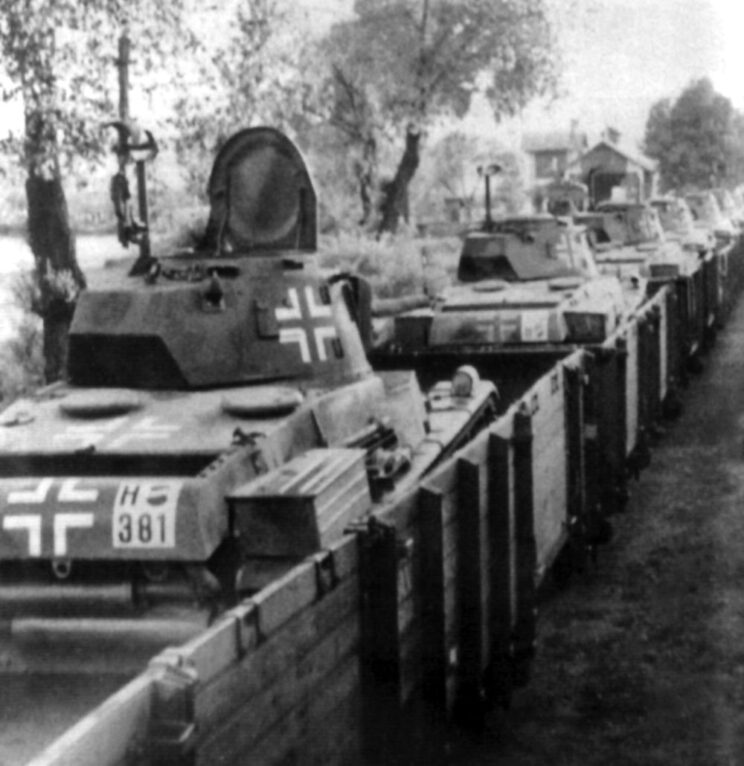
Rail transport tanks "Toldi" on the way through the Carpathians to the Eastern Front.
I must admit that the fight itself was very brutal. The Hungarians managed to gain a tactical advantage on the battlefield, and they also prevented the withdrawal of Soviet tanks towards the forest. During the Battle of Uriv, the division destroyed 21 enemy tanks without loss, mainly T-26s and M3 Stuarts, as well as several T-34s. The Hungarians have added four captured M3 Stuart tanks to their fleet.
The first contact with a Soviet armored unit made the Hungarians realize that the 37 mm PzKpfw 38(t) guns were completely useless against medium (T-34) and heavy (KW) enemy tanks. The same thing happened with infantry units, which were defenseless against enemy tanks due to the limited means available - a 40-mm anti-tank gun. Twelve of the enemy tanks knocked out in this battle became victims of the PzKpfw IV. The ace of battle was the captain. Jozsef Henkey-Hoenig of the 3rd Company of the 51st Tank Destroyer Battalion, whose crews destroyed six enemy tanks. The command of the 2nd Army turned to Budapest with an urgent request to send the appropriate tanks and anti-tank weapons. In September 1942, 10 PzKpfw III, 10 PzKpfw IV F2 and five Marder III tank destroyers were sent from Germany. By that time, the division's losses had risen to 48 PzKpfw 38(t) and 14 PzKpfw IV F1.
During the summer battles, one of the bravest soldiers was Lieutenant Sandor Horvat from the 35th Infantry Regiment, who on July 12, 1941 destroyed T-34 and T-60 tanks with magnetic mines. The same officer was wounded four times in 1942-43. and was awarded the Gold Medal for Courage. The infantry, especially the motorized ones, provided great support in the last attack of the 1st Armored Battalion and the 3rd Company of the 51st Tank Destroyer Battalion. In the end, the attacks of the Hungarian armored division forced the 4th Guards Tank Brigade and the 54th Tank Brigade to leave the bridgehead and retreat to the eastern bank of the Don. Only the 130th tank brigade remained on the bridgehead - in the Uriv sector. The retreating armored brigades left armored vehicles and motorized rifle battalions in the bridgehead.

Rest of the Hungarian battleships in the city of Kolbino; late summer 1942
Soviet losses began to increase significantly, and the struggle for the Hungarians themselves became easier when they were joined by PzKpfw IV F1 tanks and Nimrod self-propelled guns. They have completed the work of destruction. Their fire effectively prevented the retreat of the Red Army through the bridgehead. Several ferries and ferry boats were destroyed. Ensign Lajos Hegedyush, a platoon commander of a company of heavy tanks, destroyed two Soviet light tanks, which were already on the other side of the Don. This time, the Hungarian launches were minimal, with only two PzKpfw 38(t) tanks damaged. The most efficient vehicle was the one commanded by a corporal. Janos Rosik from the 3rd tank company, whose crew destroyed four enemy armored vehicles.
At the beginning of August 1942, the Soviet 6th Army tried to create and expand as much as possible bridgeheads on the western bank of the Don. The two largest were located near Uriva and Korotoyak. The command of the 2nd Army did not understand that the main blow would go to Uryv, and not to Korotoyak, where most of the 1st Panzer Division was concentrated, with the exception of the reconnaissance battalion that had just been sent to Uryv.
The attack, which began on 10 August, started very badly for the Hungarians. Artillery mistakenly set fire to the troops of the 23rd Infantry Regiment of the 20th Light Division, which began to advance on Storozhevoye on the left flank. The fact is that one of the battalions advanced too quickly. The first attack was stopped at the well-prepared defensive positions of the 53rd fortified area of the PC. A.G. Daskevich and part of the 25th Guards Rifle Division Colonel. PM Safarenko. Tankers of the 1st armored battalion met strong and determined resistance from the Soviet 29th anti-tank artillery group. In addition, special infantry groups trained in the destruction of armored fighting vehicles were waiting for the Hungarian tanks. Tank crews had to repeatedly use machine guns and hand grenades, and in some cases even fire at each other with machine guns in order to get rid of the armor of the Red Army. The attack and the whole battle turned out to be a huge failure.
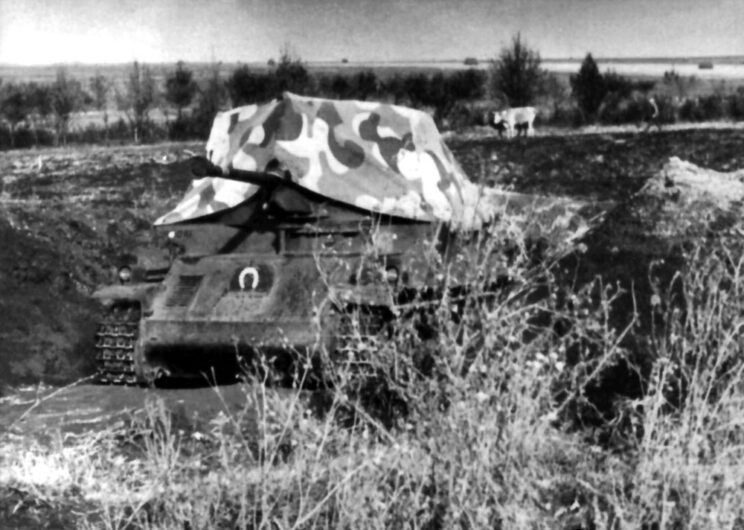
Camouflaged Nimrod self-propelled guns of the 51st Tank Destroyer Battalion, 1942
One of the tanks hit a mine near Korotoyak and burned down along with the entire crew. The Hungarian infantry suffered significant losses from the strikes of the Soviet attack and bomber aircraft; despite quite effective air defense. Lieutenant Dr. Istvan Simon wrote: “It was a terrible day. Those who have never been there will never believe it or cannot believe it... We moved forward, but faced such heavy artillery fire that we were forced to retreat. Captain Topai died [Captain Pal Topai, commander of the 2nd tank company - approx. ed.]. ... I will remember the second battle for Uryv-Storozhevo.
The next day, August 11, new battles took place in the Krotoyak area, in the early morning the 2nd tank battalion was alerted and inflicted heavy losses on the attacking Red Army. The losses on the Hungarian side were insignificant. The rest of the 1st Panzer Division fought at Korotoyak along with the German 687th Infantry Regiment of the 336th Infantry Division under General Walter Lucht.

Hungarian tank PzKpfw IV Ausf. F2 (this version featured a long-barreled 75 mm gun) from the 30th Tank Regiment, autumn 1942.
The Red Army attacked in the Krotoyak area on August 15, 1941. In a very short time, all Hungarian troops were busy repelling enemy attacks. Only on the first day, 10 Soviet tanks were destroyed, mainly M3 Stuart and T-60. The PzKpfw IV F1 of Lajos Hegedus, who destroyed four M3 Stuarts, was hit by a mine and several direct hits. The driver and radio operator were killed. During these battles, certain shortcomings in the training of the Hungarian infantry were revealed. At the end of the day, the commander of the 687th Infantry Regiment, Lieutenant Colonel Robert Brinkmann, reported to the commander of the 1st Armored Division, General Lajos Veres, that the Hungarian soldiers from his division could not establish close cooperation with his regiment on the defensive. and counterattack.
Fierce fighting continued throughout the day. The Hungarian tanks destroyed two enemy medium tanks, but suffered rather heavy losses. A very experienced officer, the commander of the 2nd company, Lieutenant Jozsef Partos, died. His PzKpfw 38(t) had little chance against the T-34. Two Hungarian PzKpfw 38(t) were mistakenly destroyed in the heat of battle by German gunners from the 687th Infantry Regiment. The fighting at Krotoyak continued for several days with varying intensity. The Hungarian 1st Armored Division on August 18, 1942, calculated its losses, which amounted to 410 killed, 32 missing and 1289 wounded. After the battle, the 30th Tank Regiment had 55 PzKpfw 38(t) and 15 PzKpfw IV F1 in full combat readiness. Another 35 tanks were in repair shops. Over the next few days, the 12th Light Division and the 1st Panzer Division were withdrawn from Korotoyak. Their place was taken by the German 336th Infantry Division, which liquidated the Soviet bridgehead in early September 1942. In this task, she was supported by the 201st assault gun battalion of Major Heinz Hoffmann and the Hungarian aviation. The Soviets realized that they did not have enough forces to hold two bridgeheads, and decided to concentrate on the most important thing for them - Uryva.
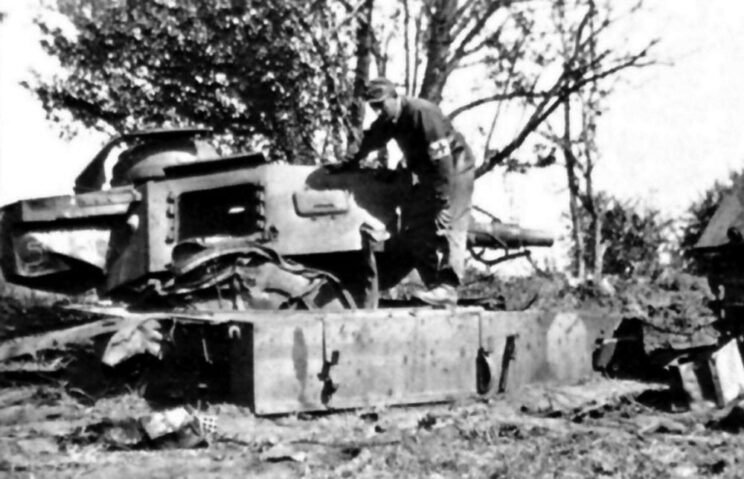
Completely destroyed PzKpfw IV Ausf. F1 Corporal Rasik; Watchtower, 1942
Parts of the 1st Panzer Division rested, replenished with personnel and equipment. Even more tanks returned from the workshops to the line units. By the end of August, the number of serviceable tanks had increased to 5 Toldi, 85 PzKpfw 38(t) and 22 PzKpfw IV F1. Reinforcements were also coming, such as four PzKpfw IV F2 tanks with a 75 mm long-barreled gun. Interestingly, by the end of August 1942, the air defense systems of the Hungarian armored division shot down 63 enemy aircraft. Of these, the Nimrod self-propelled guns from the 51st tank destroyer battalion were enrolled 40 (38?)
In early September 1942, the Hungarian soldiers were preparing for the third attempt to liquidate the Urivo-Storozhevsky bridgehead. Tankers had to play a leading role in this task. The plan was prepared by General Willibald Freiherr von Langermann und Erlenkamp, commander of the XXIV Panzer Corps. According to the plan, the main attack was to be directed at Storozhevoye on the left flank, and after its capture, the 1st Panzer Division was to attack the forest of Ottisia to destroy the rest of the Soviet troops from the rear. Then the enemy troops were to be liquidated directly on the bridgehead. Unfortunately, the German general did not take into account the proposals of the Hungarian officers, who had already fought twice in the area. The forces of the 1st Panzer Division were asked to attack the forces defending the bridgehead as quickly as possible, without breaking through the forest, directly in the direction of Selyavnoye. The German general believed that the enemy would not have time to send reinforcements across the bridge.
The offensive of the Hungarian troops on September 9, 1942 marked the beginning of one of the bloodiest chapters of the battles on the Don. On the left flank, the German 168th Infantry Division (Commander: General Dietrich Kreiss) and the Hungarian 20th Light Division (Commander: Colonel Geza Nagye), supported by the 201st Assault Gun Battalion, were to attack Storozhevoe. However, they faced strong defenses and their progress was slow. It is not surprising that the Red Army had almost a month to turn their positions into a real fortress: the dug-in T-34 tanks and 3400 mines located on the bridgehead did their job. In the afternoon, a battle group from the 1st Battalion, 30th Tank Regiment, commanded by Capt. MacLary, was sent to support the attack. Sergeant Janos Chismadia, commander of the PzKpfw 38 (t), especially distinguished himself that day. A Soviet T-34 suddenly appeared behind the attacking German infantry, but the Hungarian tank crew managed to destroy it at very close range; which was a very rare event. Immediately after that, the tank commander left his car to destroy two shelters with manual grants. On that day, he and his subordinates were able to chalk up 30 prisoners of war. The sergeant was awarded the Silver Order of Courage.
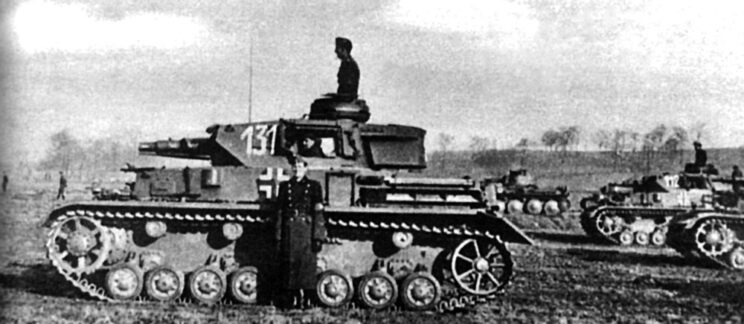
PzKpfw IV Ausf. F1. Like the Wehrmacht, the Hungarian 1st Panzer Division had too few suitable armor to fully counter the Soviet KW and T-34.
The fighting moved to the village itself and its environs on 10 September. PzKpfw IV tanks of the 3rd company destroyed two T-34s and one KW and forced the tankers of the 116th tank brigade to retreat east of the village. Two of these tanks were destroyed by a corporal. Janos Rosik. When the Hungarians, pushing the enemy back, almost left the village, Roshik's cart was hit by a 76,2-mm cannon shell. The tank exploded, the entire crew died. The 30th Tank Regiment lost one of its most experienced crews.
The combined German-Hungarian forces captured Storozhevoye, losing two more PzKpfw 38(t) tanks. During this battle, Sgt. Gyula Boboytsov, platoon commander of the 3rd company. Meanwhile, on the right wing, the 13th Light Division attacked Urive, capturing most of its targets within two days. However, over time, parts of the division were forced to retreat due to a series of massive Soviet counterattacks. By the morning of September 11, the entire Storozhev area was occupied by German-Hungarian troops. Further progress was limited by heavy rain.
In the afternoon, the Hungarian tankers were sent to attack through the Ottissia forest, but were stopped by anti-tank guns fire from shelters on the edge of the forest. Several cars are badly damaged. Peter Luksch (promoted to major at the end of September), commander of the 2nd armored battalion, was severely wounded in the chest by a shell fragment while outside the tank. The captain took command. Tibor Karpaty, current commander of the 5th company. At the same time, the 6th and 54th tank brigades were transferred to the bridgehead of the Soviet 130th Army, which included, among other things, tanks with a power of 20 kW and a lot of T-34s.
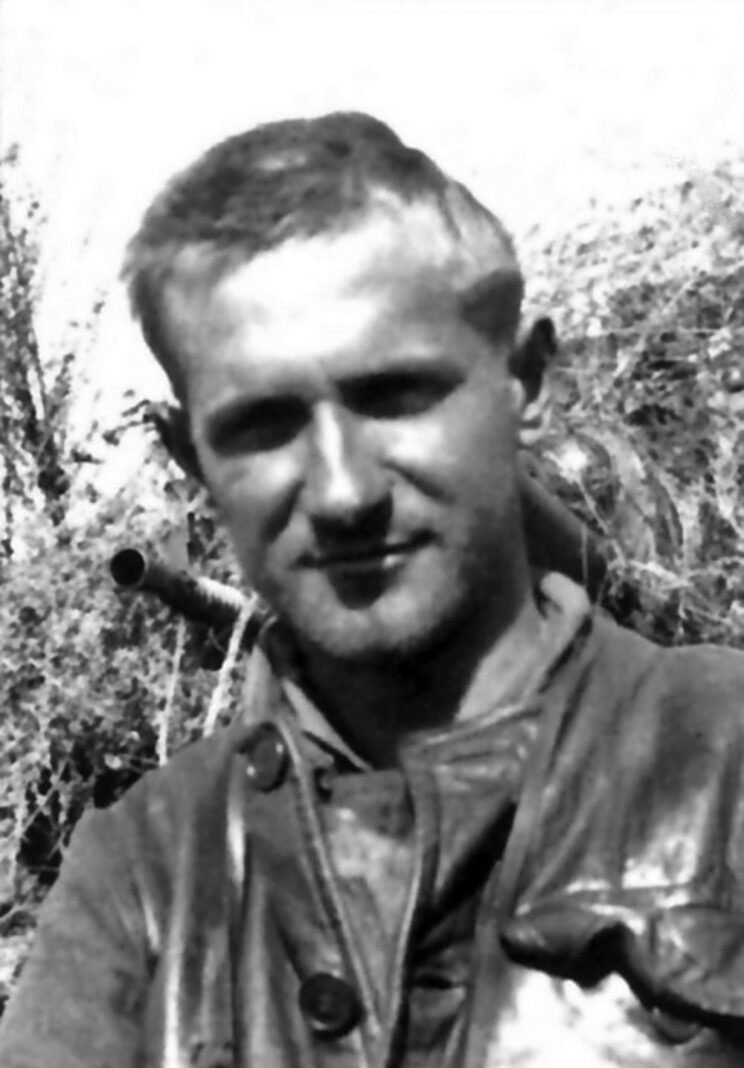
One of the best Hungarian tankers, Lieutenant Istvan Simon; 1942
September 12, 1942 the German-Hungarian troops were forced to change the main direction of the offensive. In the morning, heavy artillery fire from the eastern bank of the Don fell on the Hungarians and Germans preparing to strike. Lieutenant Colonel Endre Zador, commander of the 30th Armored Regiment, Lieutenant Colonel Rudolf Resch was seriously wounded, the command of the regiment was taken over by the commander of the 1st Armored Battalion. Despite the unsuccessful start, the attack was a success. The new regiment commander, leading the attack in the first wave, destroyed six anti-tank guns and two field guns. Reaching the foot of Hill 187,7, he left his wagon and took part in a direct attack, neutralizing two enemy hideouts. After the Hungarian tanks suffered heavy losses, the Soviet infantry drove the Hungarian infantry off the important hill in the center of the bridgehead. The soldiers of the 168th Rifle Division began to dig in on the already occupied positions. Toward evening, KW tanks appeared on the left flank. At the end of the day, a massive Soviet attack dislodged the Germans from their defensive positions at Hill 187,7. 2nd armored battalion cap. Tibor Karpatego was ordered to counterattack. Corporal Mocker described the battle that day:
We got up at 4:30 and prepared to leave the position. Corporal Gyula Vitko (driver) had a dream that our tank was hit... However, Lieutenant Halmos did not let us think too long about this confession: “Start the engines. Step!" ... It quickly became clear that we were in the center of a Soviet attack on the line of contact ... The German infantry was in their positions, ready to attack. ... I received a brief report from the platoon commander on the right flank, probably Lieutenant Attila Boyaska (platoon commander of the 6th company), who asked for help as soon as possible: “They will shoot our tanks one by one! Mine broke. We need immediate help!"
The 1st tank battalion was also in a difficult position. Its commander asked for support from the Nimrods to repel the attacking Soviet tanks. The corporal continued:
We got to the tank of Captain Karpathy, which was under heavy fire ... There was a huge cloud of smoke and dust around it. We advanced until we reached the German headquarters of the German infantry. ... a Russian tank was moving across the field under our heavy fire. Our gunner Njerges returned fire very quickly. He fired armor-piercing shells one after the other. However, something was wrong. Our shells could not penetrate the armor of the enemy tank. This helplessness was terrible! The Soviet Army destroyed the commander of the PzKpfw 38 (t) division Karpaty, who, fortunately, was out of the car. The weakness of the 37-mm guns of the Hungarian tanks was known to the Hungarians, but now it became clear that the Soviets also knew about it and were going to take advantage of it. A secret Hungarian report stated: "The Soviets fooled us during the second battle of Uriva ... T-34s destroyed almost the entire panzer division in a few minutes."
In addition, the battle showed that the armored units of the division needed the PzKpfw IV, which could fight the T-34 tanks, but there was still a problem with the KW. By the end of the day, only four PzKpfw IVs and 22 PzKpfw 38(t) were ready for battle. In the battles of September 13, the Hungarians destroyed eight T-34s and damaged two KVs. On September 14, the Red Army tried to recapture Storozhevoe, but to no avail. The last day of fighting, the third battle for Uriv, was September 16, 1942. The Hungarians fired five Nimrod self-propelled guns from the 51st tank destroyer battalion, which made the life of Soviet tankers unbearable from 40-mm rapid-fire cannons. Soviet armored units also suffered serious losses that day, incl. 24 tanks destroyed, including six KWs. By the end of the day of fighting, the 30th Tank Regiment had 12 PzKpfw 38(t) and 2 PzKpfw IV F1. German-Hungarian troops lost 10 2 people. people: 8 thousand killed and missing and XNUMX thousand injured.
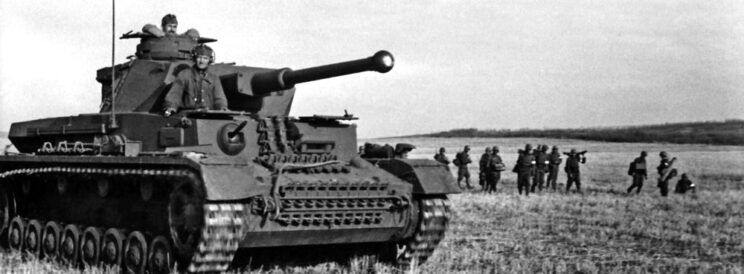
Hungarian tank PzKpfw IV Ausf. F2 and infantry in the battles for Krotoyak and Uriv; 1942
On October 3, the German XXIV Panzer Corps lost its commander, General Langermann-Erlankamp, who died from the explosion of a 122-mm rocket. Together with the German general, the commanders of the 20th Light Division and the 14th Infantry Regiment, Colonel Geza Nagy and Jozsef Mik, were killed. At the same time, the 1st Panzer Division had 50% of the starting fleet of tanks. Losses in soldiers were not so great. Seven experienced officers were sent to Hungary, including a captain. Laszlo Maclary; to participate in the training of tankers for the 2nd Panzer Division. In November, support arrived: six PzKpfw IV F2 and G, 10 PzKpfw III N. The first model was sent to a company of heavy tanks, and the “troika” to the 5th company of Lieutenant Karoli Balogh.
Reinforcements and supplies for the Hungarian armored division arrived slowly. On November 3, the commander of the 2nd Army, General Gustav Jahn, protested to the Germans in connection with the inability to deliver spare parts for tanks and supplies. Efforts were made, however, to bring in supplies and weapons as quickly as possible.
Fortunately, there were no serious quarrels. The only clash in which parts of the Hungarian armored division took part occurred on October 19, 1942 near Storozhevo; 1st armored battalion cap. Gezi Mesolego destroyed four Soviet tanks. Since November, the 1st Panzer Division was transferred to the reserve of the 2nd Army. During this time, the rifle part of the division was reorganized, becoming a motorized rifle regiment (from December 1, 1942). In December, the division received five Marders IIs, of which a tank destroyer squadron commanded by Capt. S. Pal Zergeni. To reorganize the 1st Panzer Division in December, the Germans sent 6 officers, non-commissioned officers and soldiers from the 50th Panzer Regiment for retraining.
They took part in the fighting in 1943.
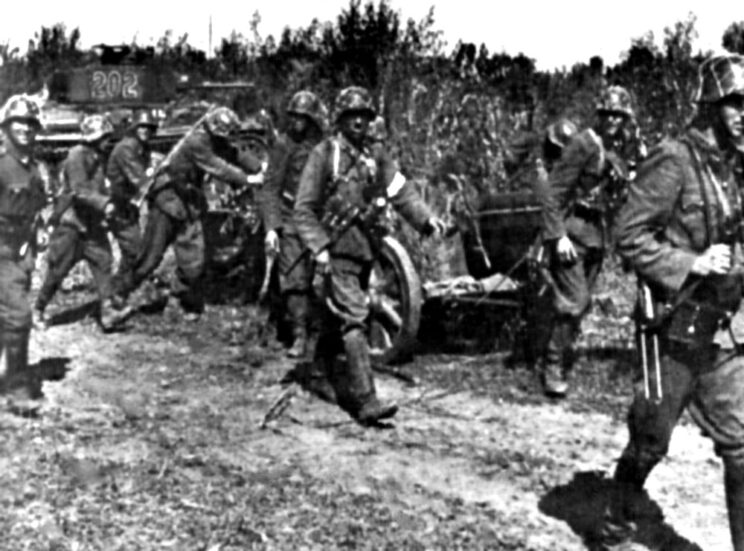
Troops of the 2nd Panzer Division on the Don, summer 1942.
On January 2, 1943, the 1st Armored Division was placed under the direct control of the corps of General Hans Kramer, which included the 29th and 168th Infantry Divisions, the 190th Assault Gun Battalion, and the 700th Armored Division. On this day, the Hungarian division included 8 PzKpfw IV F2 and G, 8 PzKpfw IV F1, 9 PzKpfw III N, 41 PzKpfw 38 (t), 5 Marder II and 9 Toldi.
Together with units of the 2nd Army, the 1st Panzer Division was responsible for the defense of the front line on the Don, with a central point in Voronezh. During the winter offensive of the Red Army, the forces of the 40th Army attacked the Uriva bridgehead, which, in addition to the guards rifle division, included four rifle divisions and three armored brigades with 164 tanks, including 33 KW tanks and 58 T-34 tanks . The Soviet 18th Rifle Corps struck from the Shutier bridgehead, including two armored brigades with 99 tanks, including 56 T-34s. He was to advance from north to south to meet the 3rd Panzer Army at Kantamirovtsy. From the side of Kantemirovka, on the southern wing, the Soviet armored army advanced, with 425 (+53?) tanks, including 29 KV and 221 T-34s. The Soviets also provided sufficient artillery support, in the Uriv sector it was 102 barrels per kilometer of front, in Shtushya - 108, and in Kantemirovtsy - 96. In the Uriv sector, 122-mm howitzers fired 9500 rounds, 76,2-mm guns - 38 rounds . , and artillery rocket launchers - 000 missiles.
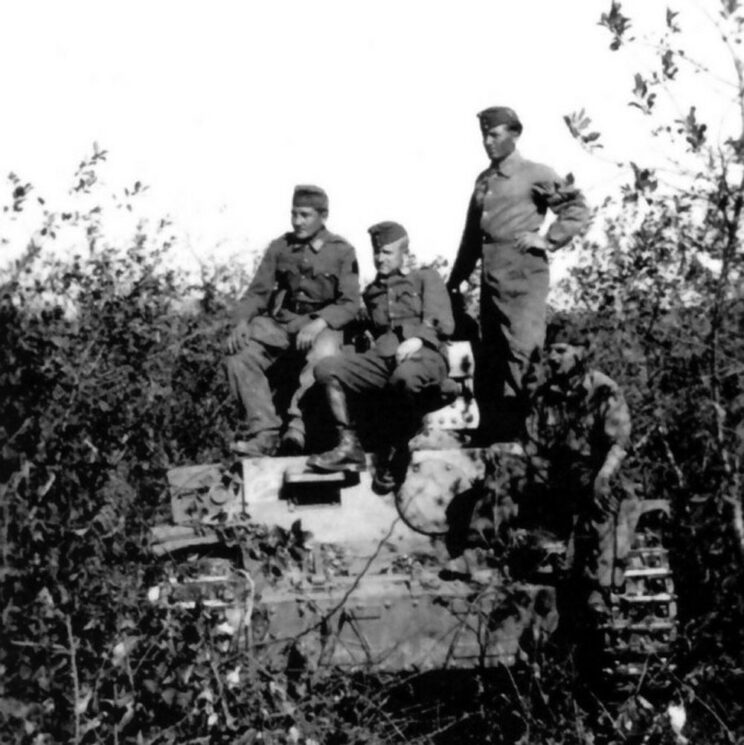
Camouflaged Hungarian tank positions; Krotoyak, August 1942.
January 12, 1943 as part of the 1st Hungarian Armored Division (commander: Colonel Ferenc Horváth, promoted to Major General in February 1943, Chief of Staff: Major Karoli
Chemez) was:
- 1st Battalion of Rapid Communications - Capt. Cornel Palotasi;
- 2nd Anti-Aircraft Artillery Group - Major Illes Gerhardt, consisting of: 1st Motorized Medium Artillery Group - Major Gyula Jovanovich, 5th Motorized Medium Artillery Group - Lieutenant Colonel Istvan Sendes, 51st Tank Destroyer Division - Lieutenant Colonel Janos Torchvari, 1st Reconnaissance Battalion – 1st Reconnaissance Battalion Lt. Ede Galosfay, XNUMXth Tank Destroyer Company – Capt. Pal Zergeni;
- 1st motorized rifle regiment - lieutenant colonel Ferenc Lovay, consisting of: 1st motorized rifle battalion - captain. Laszlo Varadi, 2nd motorized rifle battalion - Major Ishvan Khartyansky, 3rd motorized rifle battalion - captain. Ferenc Herke;
- 30th panzer pool - ppłk Andre Horváth, w składzi: kompania sztabowa - since. Matyas Fogarasi, 1. zmotoryzowana kompania saperów - kpi. Laszlo Kelemen, 1st tank battalion - captain Geza Mesoli (1st company Czolgów - squadron Janos Novak, 2nd company Cholguw - squadron Zoltan Sekey, 3rd company Czolguw - squadron Albert Kovacs), 2nd tank battalion - Dezo Vidats (4. company Czolgów - port., 5. kompania czołgów - port. Felix-Kurt Dalitz, 6. kompania czołgów - port. Lajos Balázs).
On January 12, 1943, the Red Army offensive began, preceded by massive artillery preparation, followed by six battalions supported by tanks, which attacked the 3rd Battalion, 4th Regiment, 7th Light Division. Already during the artillery shelling, the regiment lost about 20-30% of its personnel, so that by evening the enemy retreated 3 kilometers. The offensive of the Soviet troops on Uriv was supposed to begin on January 14, but it was decided to change the plan and speed up the offensive. On the morning of January 13, the Hungarian infantry battalions first came under heavy fire, and then their positions were devastated by tanks. The German 700th tank battalion, equipped with PzKpfw 38(t), was almost completely destroyed by the tanks of the 150th tank brigade. The next day, the Soviet 18th Infantry Corps attacked and crashed into the grouping of the Hungarian 12th Light Division at Shuce. The artillery of the 12th Field Artillery Regiment destroyed many Soviet tanks but could do little. The infantry began to retreat without strong artillery support. In the Kantemirovka area, the Soviet 3rd Panzer Army also broke through the German lines, its tanks taking the headquarters of the XXIV Panzer Corps at Shilino, southwest of the city of Rossosh, by surprise. Only a few German officers and soldiers managed to escape. January 14 was the coldest day of the winter of 1942/43. Colonel Yeno Sharkani, Chief of Staff of the 2nd Corps of the XNUMXth Army, wrote in a report: ...everything was frozen, the average temperature
this winter it was -20°C, that day it was -30°C.
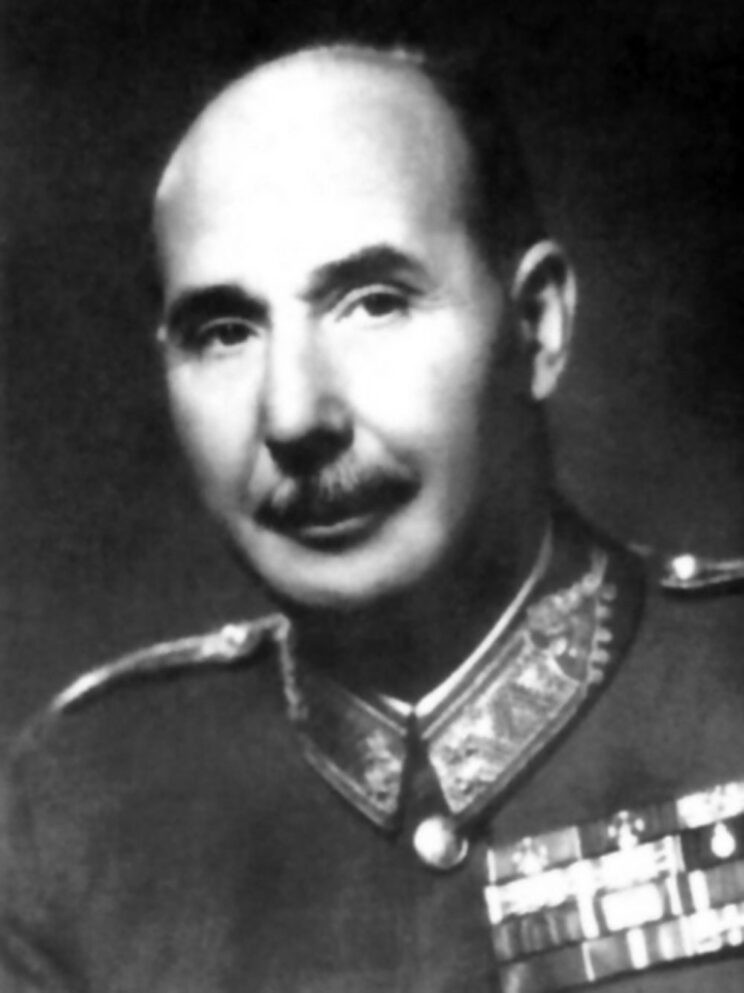
General Lajos Veres, commander of the 1st Armored Division until 1 October 1942
On the afternoon of January 16, units of the 1st Panzer Division launched a counterattack on Woitysh, occupied by the 18th Infantry Corps. As a result of a mortar attack, the commander of the 1st motorized rifle regiment, Lieutenant Colonel Ferenc Lovai, was mortally wounded. Command was taken over by Lieutenant Colonel Jozsef Szigetváry, who was quickly ordered by General Kramer to stop the counterattack and retreat as the Hungarian forces were in danger of being surrounded. By that time, the Soviets had advanced 60 km deep into the German-Hungarian lines near Uriva; the gap in the positions near Kantemirovka was huge - 30 km wide and 90 km deep. The 12th Panzer Corps of the 3rd Panzer Army has already been liberated by Rossosh. On January 17, Soviet armored units and infantry reached Ostrogoshki, which were defending units of the Hungarian 13th Light Division and a regiment of the German 168th Infantry Division.

The retreat of the Hungarian tanks PzKpfw 38 (t); December 1942
Early in the morning, the 1st Panzer Division, with eight PzKpfw IIIs and four PzKpfw IVs, launched a counterattack in the direction of Dolshnik-Ostrogoshk, destroying a Soviet motorized column. General Kramer canceled the counterattack. One of the disabled PzKpfw IVs was blown up. Unfortunately for the units of the division, there was only one road in the direction of Alekseevka, clogged with people and equipment, both active and abandoned or destroyed. The Hungarian armored division suffered significant losses during this march, mainly due to the lack of spare parts and fuel, the PzKpfw 38 (t) tanks sank in the snow, so they were abandoned and blown up. Many tanks had to be destroyed at the division's repair station in Kamenka, for example, only the 1st tank battalion had to blow up 17 PzKpfw 38 (t) and 2 PzKpfw IV and many other equipment.
On January 19, the Hungarian armored division was given the task of launching a counterstrike towards Aleksievka. To support the weakened part (until January 25), the 559th division of tank destroyers lieutenant colonel. Wilhelm Hefner. The joint attack began at 11:00. Junior Lieutenant Denes Nemeth from the 2nd Anti-Aircraft Artillery Group described the attack as follows: ... we encountered heavy mortar fire, heavy and light machine guns. One of our tanks was blown up by a mine, several other vehicles were hit ... From the very first street, a fierce battle began for every house, lane, often with a bayonet, during which both sides suffered heavy losses.

Destroyed Fiat 3000B tanks of the police unit operating in the rear of the Eastern Front; winter 1942/43
The Hungarians destroyed four enemy tanks. The fighting stopped after 2,5 hours, the Hungarians managed to recapture the city. The losses of the division were: PzKpfw III, blown up by a mine, and two PzKpfw IV, destroyed by anti-tank artillery fire. Nimrod of the 2nd Company, 51st Tank Destroyer Battalion also hit a mine, another crashed into a large ditch when his driver was shot in the head. This Nimrod was also listed as an irretrievable loss. During the attack, the commander of the PzKpfw III platoon from the 3rd tank company, Sergeant V. Gyula Boboytsov. By noon, Soviet resistance, supported by T-60 tanks, was broken by the Hungarian Marder II tank destroyers. One of the combat groups of the division was stationed on a hill near Alekseevka.
On the morning of January 19, the city was attacked by the Red Army from the south. The attack was repelled, destroying more T-34 and T-60 tanks. Despite this success, events in other sectors of the 2nd Army front forced the troops of the 1st Panzer Division to retreat further to the west. During the retreat, one of the Nimrods of the 1st company of the 51st tank destroyer battalion was destroyed. It should, however, be recognized that the insignificant success of the Hungarian armored unit on January 18 and 19 made it possible to withdraw the troops of Kramer, the 20th and 21st corps through Alekseevka. On the night of January 21-1, the battle groups of the tank division destroyed the station and the railway track in Alekseevka. On January 26, the 168th Panzer Division had to launch another counterattack to help the retreat of the German 13th Infantry Division. It was followed by troops of the German 19th Infantry Division and the Hungarian 20th Light Division defending the front at Ostrogosk until January XNUMX. The last Hungarian troops left Ostrogoshk on the peace of January XNUMX.

Albert Kovacs, one of the most successful tank commanders of the 3rd Battalion, 30th Tank Regiment.
Parts of the 1st Panzer Division, covering the retreat between Ilyinka and Alekseevka, stumbled upon a Soviet reconnaissance group, which was defeated (80 killed, two trucks and two anti-tank guns destroyed). The Hungarians occupied the western part of Alekseevka and held it all night with the support of the Marder II of the 559th Fighter Battalion. Several enemy attacks were repulsed, six people were lost. The opponent lost 150-200 of them. During the day and night of January 22, Soviet soldiers constantly attacked Ilyinka, but parts of the Hungarian armored division repelled each of the attacks. In the early morning of January 23, Marder II self-propelled guns destroyed T-34s and T-60s. On the same day, a retreat was begun from Ilyinka as a guard of the corps - or rather, what was left of it - Kramer. A new line of defense near Novy Oskol was reached on January 25, 1943.

The prototype of the Hungarian tank destroyer on the chassis of the Toldi tank. It was never put into production; 1943-1944
After several cold but quiet days, on January 20, the Soviets launched an offensive against Novy Oskol. To the north-east of this city, the 6th tank company lost its commander (see Lajos Balas, who at that time was outside the tank and was killed by a blow to the head). The attack of the enemy could not be stopped. Parts of the division began to retreat under the onslaught of the enemy. However, they were still capable of limited counterattacks, slowing down the Red Army's advance and holding back its main forces.
The fighting in the city itself was very fierce. A radio report has been preserved from them, probably sent by Corporal Miklos Jonas: “I destroyed a Russian anti-tank gun near the station. We continue our progress. We met heavy machine-gun and small-caliber fire from the buildings and from the main road junction. On one of the streets north of the station, I destroyed another anti-tank gun, which we drove over and fired at 40 Russian soldiers with machine guns. We continue our promotion...
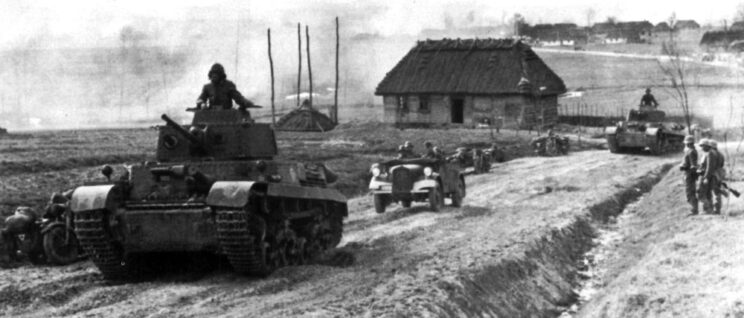
Hungarian tanks Turan and PzKpfw 38(t) in Ukraine; spring 1943
After the fighting that day, tank commander Jonas was awarded the highest Hungarian medal: the Officer's Gold Medal for Courage. As a result, parts of the division left the city and retreated to the village of Mikhailovka east of Korocha. On this day, the division lost 26 people, mostly wounded, and one PzKpfw IV tank, which was blown up by the crew. The Soviet takeoff is estimated at about 500 soldiers.
The next two days were quieter. Only on February 3, more fierce battles took place, during which the enemy battalion was pushed back from Tatyanovsky. The next day, the 1st Panzer Division repelled several Soviet attacks and recaptured the village of Nikitovka, northwest of Mikhailovka. After the withdrawal of other units to Koroche, the 1st Panzer Division also retreated. There, the Hungarians were supported by the 168th Infantry Division of General Dietrich Kreis. On February 6, there was a battle for the city, in which Soviet troops captured several buildings. In the end, the Red Army soldiers were driven out of the city.

One of the best Hungarian armored vehicles is the Zrinyi II assault gun; 1943
The very next day the city was surrounded on three sides. At 4:45 the Soviet attack began. Two combat-ready Nimrod self-propelled guns, firing in short bursts, at least for a moment stopped the attack from the east. At 6:45 am, the German column retreated. 400-500 Soviet soldiers attacked him, trying to cut him off from the city. The retreat of the Germans was supported by Nimrodius, whose massive fire allowed the column to reach its destination. The only road to Belogrud led southwest of the city. All other units have already left Krotosha. Hungarian tankers also began to retreat, fighting incessant battles. During this retreat, the last Nimrod was blown up, as well as the last PzKpfw 38 (t), destroyed in the battle with the T-34 and two T-60s. The crew survived and escaped. February 7 was the last day of major fighting that the Hungarian division fought on the eastern front.

Tank Toldi II, rebuilt according to the German model, with side armor plates; 1943
On February 9, the 1st Panzer Division crossed Donetsk and reached Kharkov. After the retreat, two Marders IIs (sent back to Germany in the summer of 1943) remained in service. The last loss was the commander of the 2nd Armored Battalion, Major Dezeu Vidats, who died in the hospital, ill with typhus, on January 21, 1943. On January 28, the division had 316 officers and 7428 non-commissioned officers and privates. The total losses of the division for January and February 1943 amounted to 25 officers killed and 50 wounded, another 9 were missing, among non-commissioned officers the numbers were as follows - 229, 921 and 1128; and among the rank and file - 254, 971, 1137. The division was sent back to Hungary at the end of March 1943. In total, the 2nd Army lost between January 1 and April 6, 1943 96 soldiers: 016 wounded, seriously fell ill and sent to frostbite in Hungary, and 28 people were killed, captured or missing. Parts of the Voronezh Front in the battles with Hungary lost a total of 044 soldiers, including 67 people killed.
The war approaches the border of Hungary - 1944
After the defeat on the Don in April 1943, the Hungarian General Staff met to discuss the causes and consequences of the defeat on the Eastern Front. All senior and junior officers understood that the plan for the reorganization and modernization of the army must be implemented, and in particular they paid attention to the need to strengthen armored weapons. Otherwise, the Hungarian units fighting against the Red Army will not have the slightest chance to fight on equal terms with Soviet tanks. At the turn of 1943 and 1944, 80 Toldi I tanks were rebuilt, re-armed with 40 mm guns and equipped with additional 35 mm armor plates on the frontal armor and side plates.
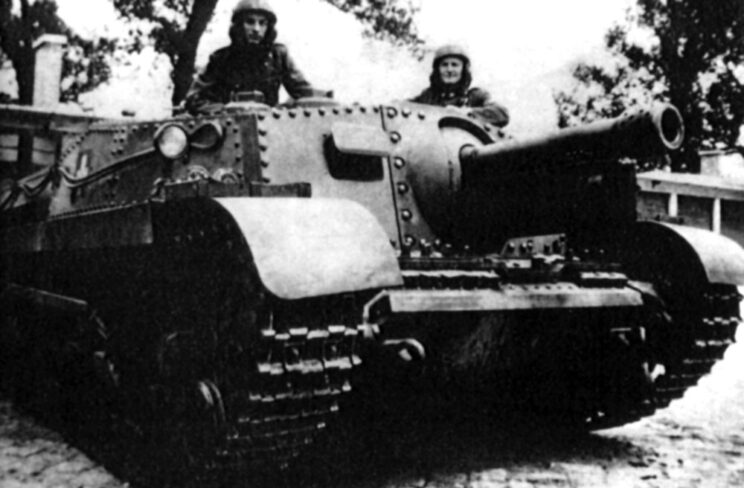
Self-propelled gun "Zrinyi II" was equipped with a 105-mm cannon; 1943
The first stage of the program was to last until mid-1944 and included the development of a new tank model - the 41M Turán II with a 75 mm gun and the Zrinyi II self-propelled artillery mount with a 105 mm gun. The second stage was to last until 1945 and its final product was to be a heavy tank of its own production and - if possible - a tank destroyer (the so-called Tas M.44 program). The second phase never took effect.
After the defeat on the Don on April 1, 1943, the Hungarian command began to implement the third plan for the reorganization of the army - "Knot III". The new 44M Zrini self-propelled gun was armed with a 43-mm MAVAG 75M anti-tank gun, and the 43M Zrini II gun was armed with a 43-mm MAVAG 105M howitzer. This technique was to be used by self-propelled artillery battalions, which were to include 21 Zrynya guns and nine Zriny II guns. The first order was 40, the second 50.
The first battalion was formed in July 1943, but it included the Toldi and Turan tanks. The first five self-propelled guns "Zriny II" rolled off the assembly line in August. Due to the low production rate of the Zrynia II, only the 1st and 10th assault gun battalions were fully equipped, the 7th assault gun battalion was equipped with German StuG III G cannons, and another Hungarian unit received German self-propelled guns Hetzer. . However, as in the German army, parts of the assault guns were part of the army artillery.
Hungarian, not armored troops.
At the same time, it became clear that the new technology has disadvantages associated with design limitations. Therefore, it was planned to remake the undercarriage of the Turan tank for the installation of a 75-mm gun. This is how the Turan III should have been created. It was also planned to convert the Toldi into a tank destroyer by installing a German 40 mm Pak 75 anti-tank gun on an armored open hull superstructure. However, nothing came of these plans. For this reason, Weiss Manfred was listed as the one that was supposed to develop and put into production a new model of the Tas tank, as well as a self-propelled gun based on it. Planners and designers largely relied on German designs - the Panther tank and the Jagdpanther tank destroyer.
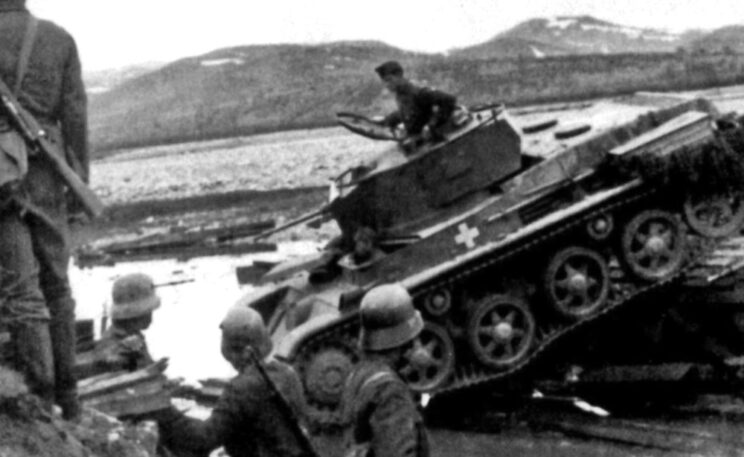
The Hungarian detachment, supported by Toldi tanks, crosses the river along the destroyed bridge; 1944
The Hungarian Tas tank was supposed to be armed with a Hungarian-made cannon, more precisely a copy of the Panther cannon, and the self-propelled gun was supposed to be armed with an 88-mm cannon, the same as the German Tiger tank was armed with. . The finished prototype of the Tas tank was destroyed during the US bombing on July 27, 1944 and was never put into production.
Even before the official entry of Hungary into the war and during the war, the Hungarian government and army tried to obtain a license from the Germans to produce a modern tank. In 1939-1940, negotiations were underway to purchase a license for the PzKpfw IV, but the Germans did not want to agree to this. In 1943, a German ally finally offered to sell the license for this tank model. The Hungarians understood that this was a reliable machine, the "workhorse of the Panzerwaffe", but considered the design outdated. This time they refused. In return, they tried to get permission to produce a newer tank, the Panther, but to no avail.
Only in the first half of 1944, when the situation at the front changed significantly, the Germans agreed to sell the license for the Panther tank, but in return they demanded an astronomical amount of 120 million ringgits (about 200 million pengő). The place where these tanks could be produced also became more and more problematic. The front was getting closer to the Hungarian borders every day. For this reason, the Hungarian armored units had to rely on their equipment and equipment provided by the German ally.
In addition, since March 1944, regular infantry divisions were reinforced with a three-battery division of self-propelled guns (regardless of the presence of an armored car platoon in the reconnaissance battalion).
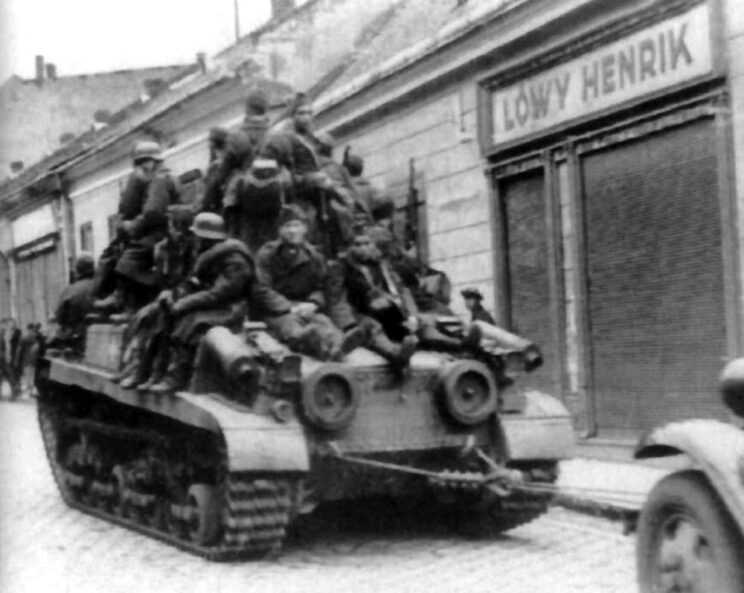
The Hungarian infantry during the retreat uses the Turan II tank; autumn 1944
Hungary's participation in the war was never very popular in society. So Regent Horthy began secret negotiations with the Allies to withdraw from the increasingly unpopular war and sign a separatist peace. Berlin discovered these actions, and on March 19, 1944, Operation Margaret began. Admiral Horthy was placed under house arrest, and a puppet government seized power in the country. At the same time, the production of tanks for the Hungarian army was completed. Under pressure from Germany, the Hungarian command sent 150 soldiers and officers of the 000st Army (commander: General Lajos Veress von Dalnoki) to plug the gap in the eastern front line that arose in southwestern Ukraine, at the foot of the Carpathians. He was part of the Army Group "Northern Ukraine" (commander: Field Marshal Walter Model).
The Germans began to reorganize the Hungarian army. The higher headquarters were disbanded, and new reserve divisions began to be created. In total, in 1944-1945, the Germans supplied Hungary with 72 PzKpfw IV H tanks (52 in 1944 and 20 in 1945), 50 StuG III G assault guns (1944), 75 Hetzer tank destroyers (1944-1945), as well as a much smaller number of tanks Pantera G, of which there were probably seven (maybe several more), and Tygrys, of which the Hungarian armored vehicles received, probably 13 pieces. It was thanks to the supply of German armored weapons that the combat strength of the 1st and 2nd Panzer Divisions was increased. In addition to the Turan I and Turan II tanks of their own design, they were equipped with German PzKpfw III M and PzKpfw IV H. The Hungarians also created eight divisions of self-propelled guns equipped with German StuG III and Hungarian Zrinyi guns.
At the beginning of 1944, the Hungarian army had 66 Toldi I and II tanks and 63 Toldi IIa tanks. The Hungarian 1st Cavalry Division was sent to fight the partisans in eastern Poland, but instead had to repel the attacks of the Red Army during Operation Bagration as part of Army Group Center. During the retreat from Kletsk towards Brest-on-Bug, the division lost 84 Turan and 5 Toldi tanks. The Germans reinforced the division with the Marder battery and sent it to the Warsaw area. In September 1944, the 1st Cavalry Division was sent to Hungary and the 1st Hussars took its place.
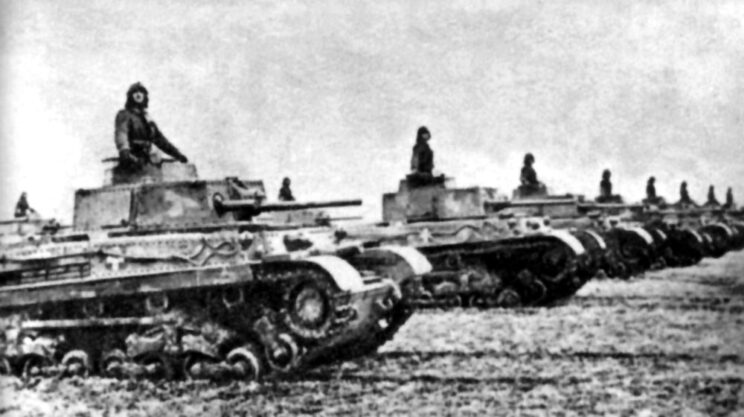
Turan II tanks belonging to the 2nd Hungarian armored division; 1944
The 1st Army, sent to the front, also included the 2nd Panzer Division (commander: Colonel Ferenc Oshtavits) and the new 1st Assault Gun Battalion. Shortly after arriving at the front, the 2nd Panzer Division launched an offensive against the Soviet lines in order to take up convenient defensive positions. During the fighting for the position described as the point of fortification 514, the Hungarian Turanians fought with Soviet T-34/85 tanks. The attack of the Hungarian armored forces began in the afternoon of 17 April. Very soon, the Hungarian Turan II tanks collided with the T-34/85, rushing to the aid of the Soviet infantry. The Hungarians managed to destroy two of them, the rest retreated. Until the evening of April 18, the forces of the division advanced in several directions on the cities of Nadvirna, Solotvina, Delatin and Kolomyia. They and the 16th Infantry Division managed to reach the railway line Stanislavov - Nadvorna.
Despite the strong resistance of the Soviet 351st and 70th Infantry Divisions, supported by the few tanks of the 27th and 8th Armored Brigades at the beginning of the attack, the 18th Reserve Hungarian Division took Tysmenich. The 2nd Mountain Rifle Brigade also achieved success, recapturing the previously lost Delatin on the right wing. On April 18, having won the tank battle for Nadvirna, the Hungarians chased and pushed back along the Prut valley to Kolomyia. However, they failed to take the stubbornly defended city. The Soviet advantage was too great. Moreover, on April 20, the 16th Infantry Division crossed the swollen waters of Bystrica and locked up the Soviet army in a small pocket near Ottyn. 500 soldiers were captured, 30 heavy machine guns and 17 guns were captured; seven more T-34/85s were destroyed in action. The Hungarians lost only 100 people. Nevertheless, their march was stopped from Kolomyia.
In April 1944, the 1st Assault Gun Battalion under the command of Captain M. Jozsef Barankay, whose Zrinya II guns performed well. On April 22, the 16th Rifle Division was attacked by the tanks of the 27th Tank Brigade. Self-propelled guns entered the battle, destroying 17 T-34/85 tanks and allowing the infantry to occupy Khelbichin-Lesny.
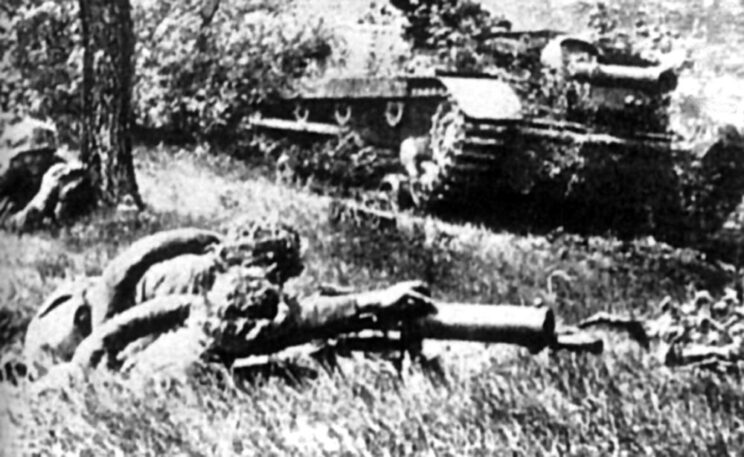
self-propelled guns "Zrinyi II" with infantry on the defensive; late summer 1944
The April offensive of the 1st Army fulfilled its main task - to pin down the Soviet troops. It also forced the Red Army to commit more units in the Kolomyia area. The continuity of the front line was restored. However, the price paid for this by the 1st Army was high. This was especially true of the 2nd Panzer Division, which lost eight Turán I tanks, nine Turan II tanks, four Toldi, four Nimrod self-propelled guns and two Csaba armored vehicles. Many other tanks were damaged or wrecked and had to be returned for repairs. The division lost 80% of its tanks for a long time. Hungarian tankers were able to keep on their account 27 wrecked enemy tanks, most of them were T-34/85 and at least one M4 Sherman. Nevertheless, the 2nd Panzer Division was unable to capture Kolomyia, even with the support of other Hungarian troops.
Therefore, a joint offensive of the Hungarian and German troops was organized, which began on the night of April 26-27 and lasted until May 2, 1944. the 73rd heavy tank battalion, commanded by a captain, took part in it. Rolf Fromme. In addition to German tanks, the 19th squadron of Lieutenant Erwin Schildey (from the 503rd company of the 2nd battalion of the 3rd armored regiment) participated in the battles, consisting of seven Turán II tanks. When the fighting ended on May 1, the company, which included the 3rd squadron, was withdrawn to the rear near Nadvirna.
The battles of the 2nd Panzer Division from April 17 to May 13, 1944 amounted to: 184 killed, 112 missing and 999 wounded. The 3rd motorized rifle regiment suffered the greatest losses, 1000 soldiers and officers had to be withdrawn from its composition. The German field commanders who fought alongside the Hungarian armored division were impressed by the courage of their allies. The acknowledgment had to be sincere, as Marshal Walter Model, commander of the Northern Ukraine Army Group, ordered equipment to be transferred to the 2nd Panzer Division, including several StuG III assault guns, 10 PzKpfw IV H tanks and 10 Tigers (later there were three others). Hungarian tankers went through a short training session in the rear of the Eastern Front. The tanks went to the 3rd company of the 1st battalion. The latter is on a par with the 2nd squadron of Lieutenant Erwin Shielday and the 3rd squadron of Captain S. Janos Vedress.
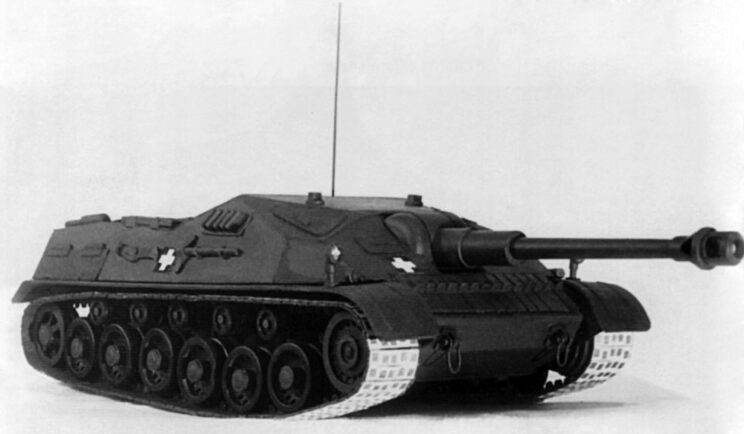
Tanks "Tiger" got into this part for a reason. Shields, an ace of the Hungarian armored forces, had 15 destroyed enemy combat vehicles and a dozen anti-tank guns. His company also received Pantera, PzKpfw IV and Turán II tanks. The lieutenant was the first to lead his platoon with five "tigers" into the attack. On May 15, the 2nd Panzer Division had three Panther tanks and four Tiger tanks in reserve. Panthers were in the 2nd Battalion of the 23rd Tank Regiment. By May 26, the number of the latter increased to 10. In June, there were no Tigers in the division. Only from July 11, six serviceable tanks of this type reappear, and on July 16 - seven. In the same month, three more "Tigers" were handed over to the Hungarians, thanks to which the total number of vehicles delivered by the Germans increased to 13. Until the second week of July, the crews of the Hungarian "Tigers" managed to destroy four T-34/85s, several anti-tank guns, and also eliminate several bunkers and ammunition depots. Positional clashes continued.
In July, the 1st Army was deployed in the Carpathians, in the Yavornik massif, in a key position before the Tatarka Pass in Gorgany. Despite the country's constant support, it was unable to hold even the 150-kilometer section of the eastern front, which was rather short for the conditions of the Eastern Front. The blow of the 1st Ukrainian Front moved to Lvov and Sandomierz. On July 23, the Red Army began an assault on the Hungarian positions. After three days of fierce fighting, the Hungarians had to retreat. Three days later, in the area of the main road leading to the city of Nadvorna, one of the Hungarian "Tigers" destroyed the Soviet column and carried out an attack on its own, during which it destroyed eight enemy tanks, several guns and many trucks. Crew gunner Istvan Lavrenchik was awarded the Gold Medal "For Courage". The rest of the crews of the "Tiger" also coped.

Comparison of the Turan II tank with the M.44 Tas heavy tank project; 1945
A counterattack by the Hungarian Tigers north of Cherneev removed the danger from Stanislavov, at least for the time being. The next day, July 24, Soviet troops attacked again and broke through the defenses. The counterattack of the Hungarian "tigers" did little to help. 3rd company captain. Miklos Mathiashi, who could do nothing but slow down the advance of the Soviet troops and cover his own retreat. Lieutenant Shieldday then won his most famous victory at the Battle of Hill 514 near the city of Staurnia. The "Tiger", commanded by the platoon commander, along with another machine of this type, destroyed 14 enemy vehicles in less than half an hour. The Soviet offensive, which lasted until early August, forced the Hungarians to retreat to the Hunyade line (the North Carpathian section of the Hungarian border). The Hungarian army lost 30 officers and soldiers in these battles,
killed, wounded and missing.
After being reinforced by two German divisions, the defense line was held despite repeated enemy attacks, especially the Dukla Pass. During these battles, the Hungarian crews had to blow up seven "Tigers" due to technical problems and the impossibility of repairing them in a retreat. Only three combat-ready tanks were removed. The August reports of the 2nd Panzer Division stated that there was not a single combat-ready Tiger at that time, only one note mentioned three tanks of this type that were not yet ready and the absence of any Panthers. Which does not mean that the latter did not exist at all. On September 14, five Panthers were again shown in operational condition. On September 30, that number was reduced to two.
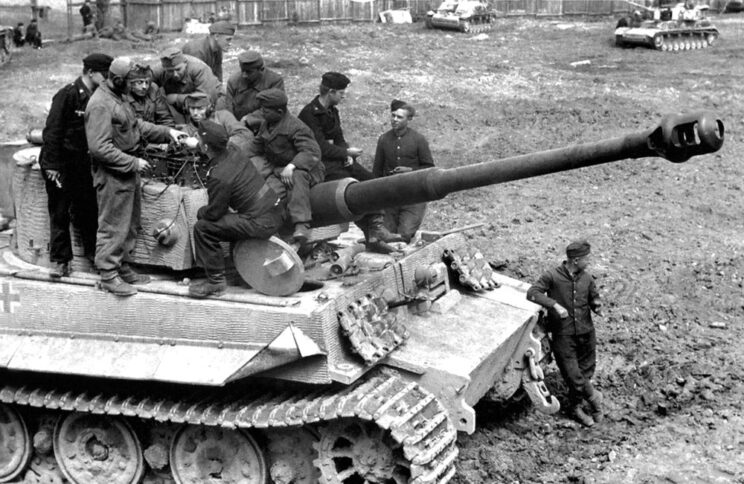
German and Hungarian tankers at the heavy tank "Tiger" of the Hungarian army; 1944
When Romania joined the USSR on August 23, 1944, the position of the Hungarians became even more difficult. The Hungarian army was forced to conduct a full mobilization and conduct a series of counterattacks against the Romanian troops in order to hold the line of the Carpathians. On September 5, the 2nd Panzer Division took part in the battles with the Romanians near the city of Torda. On August 9, the 3rd Panzer Regiment of the 2nd Panzer Division was armed with 14 Toldi I, 40 Turan I, 14 Turan II, 10 PzKpfw III M, 10 PzKpfw IV H, XNUMX StuG III G assault guns and XNUMX Tiger tanks. Three more were considered unfit for battle.
In September, in the history of Lieutenant Shieldai's division and squadron, there are Panther tanks, but no Tiger. After the loss of all the "Tigers", mainly for technical reasons and lack of fuel while covering the retreat of the Hungarian units, "Panthers" were delivered to him. In October, the number of Panthers increased by one tank to three. These cars were also put to good use. Their crews, with minimal training, managed to destroy 16 Soviet tanks, 23 anti-tank guns, 20 nests of heavy machine guns, and they also defeated two infantry battalions and a battery of artillery rocket launchers. Some of the guns were directly knocked out by Shildi's tanks when breaking through the Soviet lines. The 1st Panzer Division took part in the battles for Arad from 13 September to 8 October. By mid-September, the Red Army entered the battle on this sector of the front.
At the end of September 1944, Hungary, the last obstacle on the way to the southern border of Germany, was directly threatened by the advance of the Red Army from three sides. The autumn Soviet-Romanian offensive, despite the use of all reserves by the Hungarians, did not get stuck in the Carpathians. During fierce fighting near Arad (September 25 - October 8), the Hungarian 1st Panzer Division, supported by the 7th Assault Gun Battalion, destroyed more than 100 Soviet combat vehicles. The crews of the assault guns of the battalion were able to credit 67 T-34/85 tanks to their account, and another dozen vehicles of this type were recorded as damaged or possibly destroyed.
The units of Marshal Malinovsky crossed the Hungarian border on October 5, 1944. The next day, five Soviet armies, including one armored one, launched an offensive against Budapest. The Hungarian army put up stubborn resistance. For example, during a counterattack on the Tisza River, Lieutenant Sandor Söke's 7th Assault Gun Battalion, supported by a small detachment of infantry and military police, inflicted heavy losses on the infantry and destroyed or captured T-34 /. 85 tanks, self-propelled guns SU-85, three anti-tank guns, four mortars, 10 heavy machine guns, 51 transporters and a truck, 10 off-road cars.
Sometimes the assault gun crews showed courage even without being protected by the armor of their vehicles. Four tankers from the 10th Assault Gun Battalion under the command of CPR. Jozsef Buzhaki made a sortie behind enemy lines, where he spent more than a week. They collected invaluable information about the forces and plans of the enemy, and all this with the loss of one dead. However, local successes could not change the general bad situation at the front.
In the second half of October, the Hungarian Nazis from the Arrow Cross Party (Nyilaskeresztesek - Hungarian National Socialist Party) of Ferenc Salas came to power in Hungary. They immediately ordered a general mobilization and intensified their persecution of the Jews, who had previously enjoyed relative freedom. All men between the ages of 12 and 70 were called to arms. Soon the Hungarians placed at the disposal of the Germans four new divisions. Regular Hungarian troops were gradually reduced, as were divisional headquarters. At the same time, new mixed German-Hungarian units were being formed. The higher headquarters were disbanded and new reserve divisions were created.
On October 10-14, 1944, the cavalry group of General Piev from the 2nd Ukrainian Front, advancing on Debrecen, was cut off by the Fretter-Pico Army Group (German 6th and Hungarian 3rd Armies), mainly the 1st Hussar division, 1st Armored Division. division and the 20th Infantry Division. These forces lost Nyiregyhaza on 22 October, but the city was recaptured on 26 October. The Hungarians sent all available units to the front. The convalescents themselves volunteered to defend their homeland, as the twice wounded ace of the Hungarian armored vehicles, Lieutenant Erwin Shieldey, insisted that he remain in the squadron. On October 25, south of Tisapolgar, his unit, or rather he himself at the head, destroyed two T-34/85 tanks and two self-propelled guns in a counterattack, and also destroyed or captured six anti-tank guns and three mortars. Five days later, the squadron, still in the same area, was surrounded by Red Army soldiers at night. However, he managed to escape from the encirclement. Hungarian tanks and assault guns, supported by infantry, destroyed a Soviet infantry battalion in a battle on the plain. During this battle, the Pantera Shieldaya was hit by an anti-tank gun from a distance of only 25 m. The tank withstood the hit and rammed the gun. Continuing the offensive, the Hungarians surprised the Soviet artillery battery on the march and destroyed it.
The attack on Budapest was of great strategic and propaganda importance for Stalin. The offensive began on October 30, 1944, and on November 4, several Soviet armored columns reached the outskirts of the Hungarian capital. However, the attempt to quickly capture the city failed. The Germans and Hungarians, taking advantage of the moment of respite, expanded their defensive lines. On December 4, Soviet troops advancing from the south reached Lake Balaton, in the rear of the Hungarian capital. At this time, Marshal Malinovsky attacked the city from the north.
Hungarian and German units were assigned to defend the Hungarian capital. The SS Obergruppenführer Karl Pfeffer-Wildenbruch commanded the Budapest garrison. The main Hungarian units were: I Corps (1st Armored Division, 10th Infantry Division (mixed), 12th Reserve Infantry Division and 20th Infantry Division), the Bilnitzer Artillery Assault Battle Group (1st Battalion armored cars, 6th, 8th and 9th assault artillery battalions), 1st hussar division (some units) and 1st, 7th and 10th assault artillery battalions. Assault guns actively supported the defenders, along with police battle groups that knew the city well and had L3 / 35 tankettes at their disposal. The German units of the Budapest garrison are primarily the IX SS mountain corps. There were 188 soldiers surrounded.
The only major Hungarian armored unit still active was the 2nd Panzer Division. She fought at the front west of Budapest, in the Vertes mountains. Soon she was to move to save the city. German armored divisions also had to rush to the rescue. Hitler decided to withdraw the 1945th SS Panzer Corps from the Warsaw area and send it to the Hungarian front. It was to be merged with the XNUMXth SS Panzer Corps. Their goal was to unblock the besieged city. In January XNUMX, the SS Panzer Corps tried three times to break into the besieged Hungarian capital west of Budapest.
The first attack began on the night of January 2, 1945 on the Dunalmas-Banchida sector. The 6th SS Panzer Corps was deployed with the support of the 3rd Army of General Hermann Balck, a total of seven panzer divisions and two motorized divisions, including selected ones: the 5th SS Panzer Division Totenkopf and the 2nd SS Panzer Division. Viking, as well as the 31st Hungarian Panzer Division, supported by two battalions of heavy Tiger II tanks. The shock group quickly broke through the front, defended by the 4th Guards Rifle Corps, and wedged into the defenses of the 27th Guards Army to a depth of 31-210 km. There was a crisis situation. Anti-tank defense points were left without infantry support and were partially or completely surrounded. When the Germans reached the Tatabanya region, there was a real threat of their breakthrough to Budapest. The Soviets threw more divisions into the counterattack, 1305 tanks, 5 guns and mortars were used to support them. Thanks to this, by the evening of January XNUMX, the German attack was stopped.
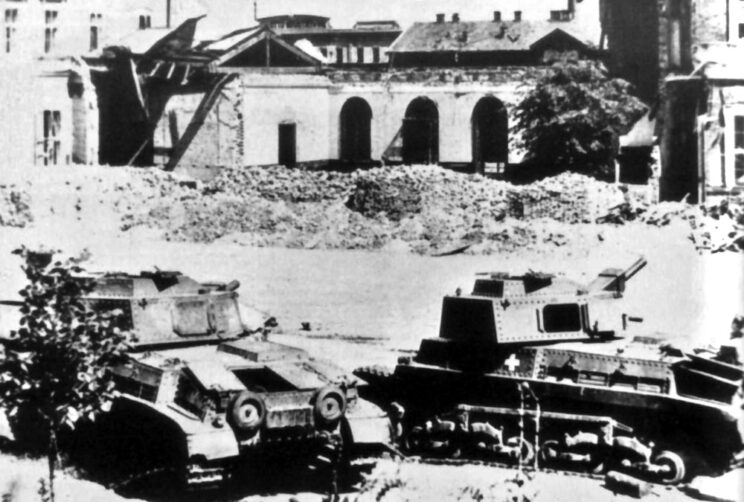
Having failed in the zone of the 31st Guards Rifle Corps, the German command decided to break through to Budapest through the positions of the 20th Guards Rifle Corps. For this, two SS Panzer divisions and partly the Hungarian 2nd Panzer Division were concentrated. On the evening of January 7, the German-Hungarian offensive began. Despite the infliction of huge losses on the Soviet troops, especially in armored vehicles, all attempts to unblock the Hungarian capital ended in failure. Army Group "Balk" managed to recapture only the village of Szekesfehervar. By January 22, she reached the Danube and was less than 30 km from Budapest.
The Army Group "South", which occupied positions from December 1944, included: the German 8th Army in the northern Transdanubian Territory; Army Group Balk (German 6th Army and Hungarian 2nd Corps) north of Lake Balaton; 2nd Panzer Army with the support of the 1945th Hungarian Corps in the south of the Transdanubian Territory. In Army Group Balk, the German LXXII Army Corps fought the St. Laszlo Division and the remnants of the 6th Armored Division. In February 20, these forces were supported by the 15th SS Panzer Army, consisting of three panzer divisions. XNUMXth Assault Gun Battalion under the command of Major. The József Henkey-Hing was the last unit of this type in the Hungarian army. He participated in Operation Spring Awakening with XNUMX Hetzer tank destroyers. As part of this operation, these forces were to regain control of the Hungarian oil fields.
In mid-March 1945, the last German offensive at Lake Balaton was defeated. The Red Army was completing the conquest of Hungary. His superior forces broke through the Hungarian and German defenses in the Vertesz mountains, pushing the German 6th SS Panzer Army to the west. With great difficulty, it was possible to evacuate the German-Hungarian bridgehead at the Gran, supported mainly by the forces of the 3rd Army. In mid-March, Army Group South went on the defensive: the 8th Army took up positions north of the Danube, and the Balk Army Group, consisting of the 6th Army and the 6th Army, took up positions south of it in the area to Lake Balaton. Tank Army SS, as well as the remnants of the Hungarian 3rd Army. South of Lake Balaton, positions were held by units of the 2nd Panzer Army. On the day the Soviet troops began their offensive on Vienna, the main German and Hungarian positions were at a depth of 5 to 7 km.
On the main line of advance of the Red Army were units of the 23rd Hungarian Corps and the 711th German SS Panzer Corps, which included: the 96th Hungarian Infantry Division, the 1st and 6th Infantry Divisions, the 3rd Hungarian Hussar Division , the 5th Panzer Division, the 2nd SS Panzer Division "Totenkopf", the 94th SS Panzer Division "Viking" and the 1231st Hungarian Panzer Division, as well as a number of smaller troops and battle groups, often left over from previously destroyed in combat parts. This force consisted of 270 infantry and motorized battalions with XNUMX guns and mortars. The Germans and Hungarians also had XNUMX tanks and self-propelled guns.
On March 16, 1945, the Red Army delivered a blow with the forces of the 46th Army, the 4th and 9th Guards Armies, which were supposed to reach the Danube near the city of Esztergom as soon as possible. This second operational formation with full personnel and equipment was just created to strike at parts of the 431st SS Panzer Corps in the area between the settlements of Szekesfehervar - Chakberen. According to Soviet data, the corps had 2 guns and a howitzer. His battle group was as follows: on the left wing was the 5th Hungarian Panzer Division (4 divisions, 16 artillery batteries and 3 Turan II tanks), in the center - the 5th SS Panzer Division "Tontenkopf", and on the right wing - 325th Panzer Division. SS Panzer Division Viking. As a reinforcement, the corps received the 97th Assault Brigade with XNUMX guns and several other support units.
On March 16, 1945, the 2nd and 3rd Ukrainian Fronts attacked the 6th SS Panzer Army and the Balk Army Group, captured Szombathely on March 29, and Sopron on April 1. On the night of March 21-22, the Soviet offensive across the Danube crushed the defensive lines of the Germans and Hungarians on the Balaton-Lake Velences line, near Esztergom. It turned out that the Hungarian 2nd Panzer Division suffered the greatest losses from the hurricane artillery fire. His troops were unable to hold their positions, and the advancing units of the Red Army managed to capture the city of Chakberen relatively easily. German reserve forces rushed to help, but to no avail. They were too small to stop the Soviet attack even for a short time. Only some of its parts, with great difficulty and even greater losses, escaped from trouble. Like the rest of the Hungarian and German armies, they were heading west. On April 12, Army Group Balk reached the borders of Austria, where it soon capitulated.
